
Published by W.D. Hoard & Sons Co. August/September 2022 hayandforage.com Low alfalfa yields can be tiring pg 10 Ship hay or ship cattle? pg 12 Corn silage harvest errors pg 26 Stockers performed well on alfalfa-bermudagrass pg 30
That’s the promise of the 6E. When cutting a hayfield, mowing a roadside and lifting dense round bales is all in a day’s work, efficiency gained is gold. Both experienced pros and new operators benefit from the intuitive controls, smooth handling and improved comfort.
Get more utility from your utility tractor with the 6E. Available with your choice of a 12F/12R or 24F/12R PowrReverserTM transmission, up to 135 horsepower, open station or cab, 2WD or MFWD. With maximum utility comes maximum production.
Talk to your John Deere dealer about this all-in-one tractor.





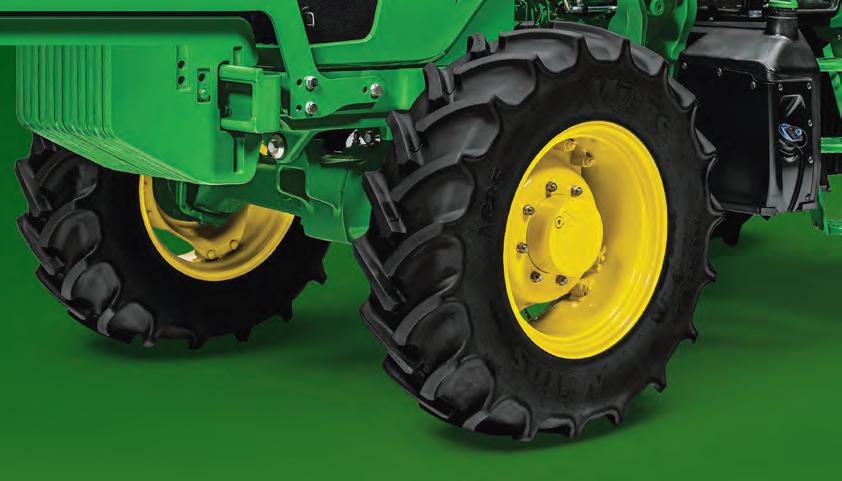



JohnDeere.com/6E






JohnDeere.com/MoCo
JohnDeere.com/Balers

As versatile as the farmer who uses it.
Brian Mumm has a passion for the commercial hay business. He’s hoping that trait is inherited by one of his children.
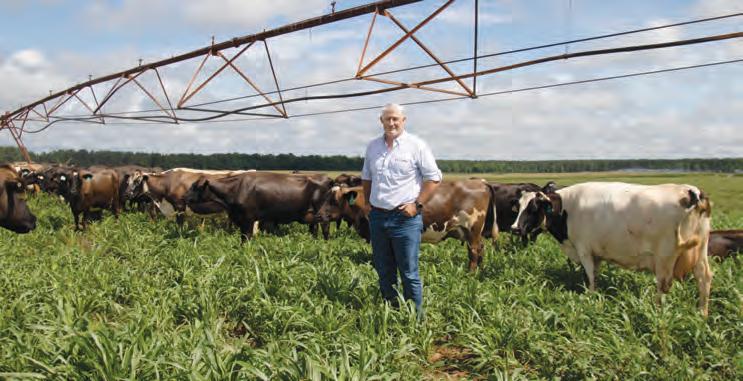


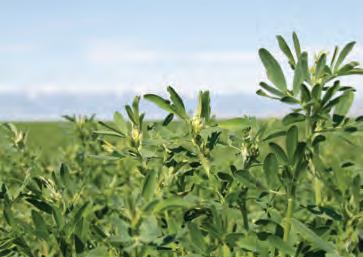
Alfalfa that is grown and harvested at high altitudes has an inherent forage quality advantage.
MANAGING
ART
ADVERTISING SALES
Kim E. Zilverberg kzilverberg@hayandforage.com Jenna Zilverberg jzilverberg@hayandforage.com
ADVERTISING COORDINATOR
Patti J. Kressin pkressin@hayandforage.com
W.D. HOARD & SONS
PRESIDENT Brian V. Knox
EDITORIAL OFFICE
28 Milwaukee Ave. West, Fort Atkinson, WI, 53538 WEBSITE www.hayandforage.com
EMAIL info@hayandforage.com PHONE 920-563-5551
Dennis Mashek cuts some high-yielding, bootstage triticale late last May near Calmar, Iowa. He farms 1,000 acres along with his wife, Barb, and their two sons, Tanner and Josh. Alfalfa and corn silage provide the base forages for the dairy herd. The seventh-generation Hilltop Acres Farm is home to 450 high-producing Brown Swiss cows that average 28,500 pounds of milk, 1,300 pounds of fat, and 1,000 pounds of protein. Hilltop Acres cattle are genomic tested and have been sold around the world.
by Mike Rankin
HAY & FORAGE GROWER (ISSN 0891-5946) copyright © 2022 W. D. Hoard & Sons Company. All rights reserved. Published six times annually in January, February, March, April/May, August/September and November by W. D. Hoard & Sons Co., 28 Milwaukee Ave., W., Fort Atkinson, Wisconsin 53538 USA. Tel: 920-563-5551. Fax: 920-563-7298. Email: info@hayandforage.com. Website: www.hayandforage.com. Periodicals Postage paid at Fort Atkinson, Wis., and additional mail offices. SUBSCRIPTION RATES: Free and controlled circulation to qualified subscribers. Non-qualified subscribers may subscribe at: USA: 1 year $20 U.S.; Outside USA: Canada & Mexico, 1 year $80 U.S.; All other countries, 1 year $120 U.S. For Subscriber Services contact: Hay & Forage Grower, PO Box 801, Fort Atkinson, WI 53538 USA; call: 920-563-5551, email: info@hayandforage.com or visit: www.hayandforage.com. POSTMASTER: Send address changes to HAY & FORAGE GROWER, 28 Milwaukee Ave., W., Fort Atkinson, Wisconsin 53538 USA. Subscribers who have provided a valid email address may receive the Hay & Forage Grower email newsletter eHay Weekly.
August/September 2022 · VOL. 37 · No. 5 6
18
This grazing dairy is a work of Hart Hart Dairy has found ways to keep cows cool and fed during the hot Georgia summers. Milk from the dairy is processed and sold in local retail outlets.
Alfalfa kept him on the farm
Altitude adds energy value to alfalfa hay
22
10 LOW ALFALFA YIELDS CAN BE TIRING 11 BREAKING OUT THE CRYSTAL BALL 12 SHIP HAY OR SHIP CATTLE? 13 SOIL AND GRASSLANDS SERVE EACH OTHER 16 DOUBLECROPPING IS ABOUT TIMING 20 CREATE HERD EFFECT WITH ADAPTIVE GRAZING 25 LET FORAGE BUILD A BETTER FEEDER CALF 26 THESE FIVE CORN SILAGE HARVEST ERRORS OCCUR TOO OFTEN 28 FORAGE AND FEED PROTEINS ARE COMPLEX 30 STOCKERS PERFORMED WELL ON ALFALFABERMUDAGRASS ON THE COVER 4 First Cut 11 Forage Gearhead 12 The Pasture Walk 13 Sunrise on Soil 14 Alfalfa Checkoff 16 Dairy Feedbunk 25 Beef Feedbunk 28 Feed Analysis 38 Forage IQ 38 Hay Market Update DEPARTMENTS
Photo
Rankin
EDITOR Michael C.
DIRECTOR
Todd Garrett
EDITORIAL COORDINATOR Jennifer L. Yurs
ONLINE MANAGER Patti J. Hurtgen
DIRECTOR OF MARKETING John R. Mansavage
August/September 2022 | hayandforage.com | 3
Mike Rankin Managing Editor

F is for fall and forage
REFLECTING back to fifth-grade science class, you might recall that the Earth rotates on an axis of about 23.5 degrees. We live on a planet that is just a little off kilter, so to speak. As such, the distance of the sun from the Earth’s surface varies depending on where you hang your hat.
The Earth’s rotation on its axis is cause for day and night. Its revolution around the sun is why we have seasons. Almost always, as a result of the tilt, either the Northern or Southern Hemi sphere will be closest to the sun. However, there are two times of the year when the Earth’s axis is tilted neither toward nor away from the sun. One of these times is the autumnal equinox, which occurs between September 21 and 24, depending on the year.
It is at this time that the length of day and night are about equal in the Northern and Southern Hemispheres. During the equinox, the sun rises due east and sets due west when viewed from the equator. As for the rest of the world, the sun’s rays are neither at their closest nor farthest from landfall. In other words, temperatures are moderate with winter approaching in the Northern Hemisphere and summer on its way below the equator.
It’s the period on both sides of the now approaching autumnal equinox that we call fall, although it doesn’t officially begin until the equinox. At this time, most of our warm-season grasses have rounded the final turn and are headed down the growing season’s home stretch. It’s also a time when many cool-season grasses act as if they’ve guzzled a few Red Bulls and accept an extra dose of high forage quality — compliments of Mother Nature.
Fall often brings the desired combo of sunshine and cooler temperatures. This helps promote plant photosynthesis and the buildup of nonstructural carbohydrates while minimizing nighttime plant respiration and the breakdown of those same sugars. The cooler temperatures also have a positive impact on fiber digestibility. In short, fall-grown forage is cattle candy that easily translates into more gain and milk. The rapid decline in forage quality with advancing plant maturity is largely mitigated in the fall. Late fall-harvested alfalfa proves this point.
There are several ways to capitalize on the fall forage advantage. Fall stockpiling grass pastures has changed the landscape of grazing
operations from north to south and extended the grazing season by as much as 40 to 60 days on some farms. Tall fescue excels as a fall-stockpiled forage, but many other cool-season grasses and even bermudagrass also perform well in such a system.
Fall-stockpiled forage allows for grazing deep into the late fall and early winter, saving dramat ically on stored feed resources. Strip-grazing the fall-grown forage drastically improves utilization percentage and grazing days. If you graze cattle and don’t have a stockpiling plan, you’re missing out on a valuable and profitable strategy.
Another popular fall forage opportunity now being used involves the seeding of oats during late summer. Don’t think of late summer-sown oats in the same way you think of spring-sown oats. They’re two different forages when cut or grazed before the boot stage. Whereas springsown oats begin under cool conditions and finish under warm temperatures, it’s just the opposite for late summer-sown oats, which grow through the fall and are high in sugars but low in fiber.
Ryegrass also flourishes when seeded in the fall. In the South, it often provides the backbone of spring grazing, being fall interseeded into warm-season grass pastures. If seeded into a clean-tilled field, ryegrass can be planted earlier in the fall and used for late fall or early winter grazing. In the spring, ryegrass can either be grazed or cut and harvested as baleage.
Finally, there is the seeding of winter annuals in the fall. Although these don’t usually offer fall forage per se, the need for an adequate fall growth period to maximize yields during the next spring is well documented. Winter rye and triticale are the popular choices for spring forage, although other options are available, especially in the South.
Don’t cash in your 2022 forage chips just because September is approaching. There’s still ample opportunity to take advantage of fall’s sunshine, cool temperatures, and moisture to keep cattle grazing or fill storage structures. Enjoy this year’s autumnal equinox on September 22, knowing that the forage-growing season is still alive and well. •
Write Managing Editor Mike Rankin, 28 Milwaukee Ave., P.O. Box 801, Fort Atkinson, WI 53538 call: 920-563-5551 or email: mrankin@hayandforage.com

FIRST CUT
4 | Hay & Forage Grower | August/September 2022
BALING WITHOUT COMPROMISE

KUHN offers the most efficient and versatile range of fixed and variable chamber round balers available on the market.
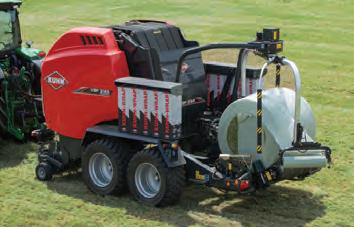



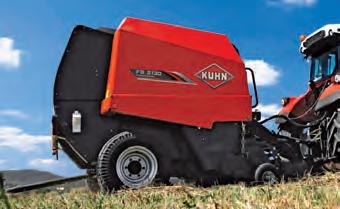
These round balers ensure consistent, perfectly shaped round bales and produce exceptionally high bale densities even in the most demanding conditions.
No matter if you’re baling dry hay, corn stalks, high-density baleage or anything in between, KUHN round balers are ready to work for you.
Visit our website to locate a Dealer near you!
A BALER FOR EVERY OPERATION INVEST IN QUALITY ® www.kuhn.com
VB
VB 7100 Series Variable
Balers VBP 3165 BalePack (Baler-Wrapper Combo) VB 3100 Series Variable Chamber Balers
FB Fixed Chamber Balers
560 Variable Chamber Baler
Chamber
THIS GRAZING DAIRY IS A WORK OF HART
by Amber Friedrichsen
WAYNESBORO, Ga., is the bird dog capital of the world. It is home to the Georgia Field Trials, an annual competition where hounds hunt down flocks of quail. To commemorate this event, the town has many businesses named for the canine companion and is speckled with murals of English Setters and German Shorthaired Pointers. A silhouette of a bird dog is even
painted on the city’s water tower.
While the term “bird dog” is typically used as a noun to describe a pet that has been trained to retrieve winged game, it can also be used as a verb. To bird dog means to pursue something with relentless determination. An example of this is how Richard Watson became the founding farmer of Hart Dairy just a few miles east of Waynesboro.
Watson grew up in New Zealand where most of the animal agriculture is pasture-based. After earning a doc-
torate in animal science and grazing techniques, he came to the U.S. as a postdoctoral research assistant in a plant breeding lab at the University of Georgia, and later served as the forage extension specialist for Mississippi State University. Then, in 2007, Watson decided to raise livestock himself.
The self-appointed dairyman envisioned an operation where cattle could graze 365 days a year — much like they do Down Under. However, he knew from his work in research and extension that
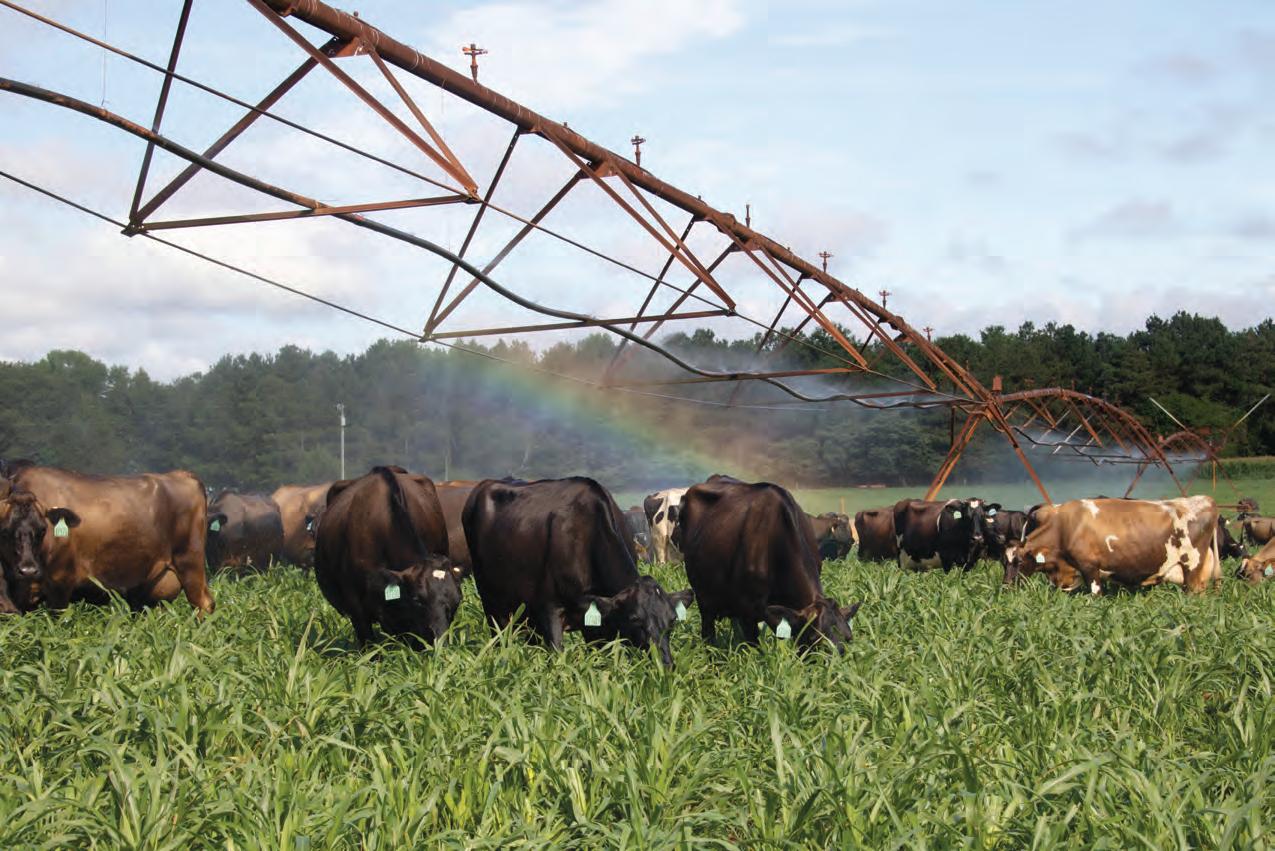
6| Hay & Forage Grower | August/September 2022
Amber Friedrichsen
he would need to establish a comprehensive crop rotation plan to ensure constant forage growth in the hot, humid climate of the southeastern U.S. To do this, Watson would have to start from scratch.
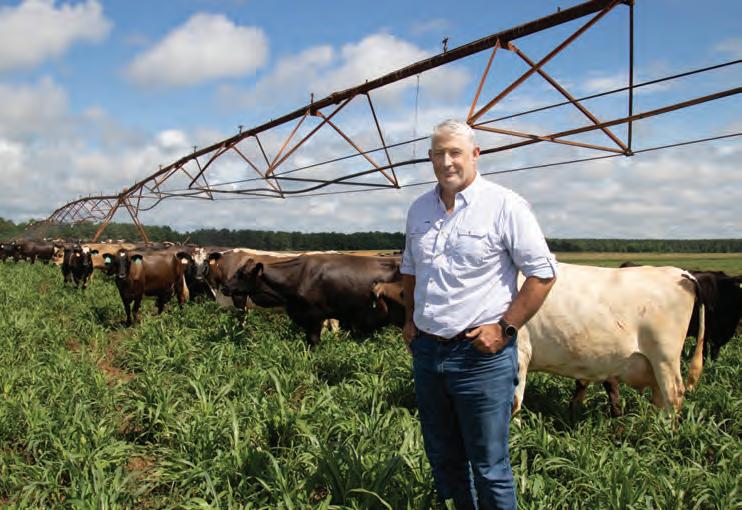
He bought a farm that was previously used to grow corn and soybeans with fine sandy loam soils that were virtually depleted of nutrients and organic matter. Then, he began seeding acres of the idle cropland to Tifton 85 bermudagrass and experimenting with different cool- and warm-season annuals to figure out how to bolster feed supplies year-round.
Over time, Watson pieced together his puzzle of a grazing plan and eventually developed a dynamic forage system that became the foundation for Hart Dairy. Today, the operation comprises about 2,000 acres across three farms and has the capacity to milk nearly 2,500 cows.
Watson takes pride in the fact that his cattle graze fresh grass every day, yet he has little desire to market his products as 100% grass-fed. Instead, he is committed to a more holistic approach.

“We put the cows first,” the expert grazier said. “We don’t push ‘100% grass-fed’ because I don’t believe cattle should be fed nothing but grass. I think they need to be supplemented when grass doesn’t meet the nutritional needs of a dairy cow by itself.”
Forage and feedstuffs
To guarantee cows have access to grass every day, different areas of Hart Dairy are dedicated to growing different forages. Bermudagrass pastures make up roughly 30% of the land, and cattle rotate through these fields on the shoulders of winter and summer grazing seasons. These pastures are also harvested for dry hay once or twice a year.
The rest of the land is used for annual crop production. Cool-season species such as wheat, oats, and annual ryegrass are seeded in the fall. Then in the spring, these acres are transitioned to pearl millet, as well as some sudangrass, crabgrass, and sorghums.
“There is a period in the year when these species overlap,” Watson explained. “We don’t have a set planting date; we have multiple planting dates. As the annual ryegrass and small grains slowly start to die out, we start putting millet in. So, by the time the winter annuals are gone, millet is ready to graze.”
This process commences sometime
in late April and is complete by midJune. Millet is seeded at a rate of 15 to 20 pounds per acre with a no-till drill to avoid disturbing the light soil. And to mitigate excessive drainage and encourage better plant growth, each field is irrigated with a center pivot. Because of the pattern formed by the center pivots, pastures are circular and divided into 10- to 15-acre paddocks that are shaped like slices of pie. The fences that divide the paddocks are springloaded so the pivots can drive over top of them to get from one wedge to the next. A sprinkler system has also been installed along the pivots to cool cattle,
and each paddock has two water troughs that are fed by an underground well.
With ample irrigation water and suitable growing conditions in the summer, sufficient crop yields are rarely a concern. Millet usually offers adequate energy levels as well, even for lactating cattle. Protein, on the other hand, becomes a limiting factor in terms of nutrition.
“Once the millet gets going, it very rapidly becomes a forage surplus,” Watson said. “We have plenty of grass, but as we near the end of the season, crude protein levels start to drop off. At that time, we supplement with canola oil or soybean meal.”
Excess millet is also harvested for baleage, but Watson has recently given this strategy a second thought. Rather than risk improper storage and gamble with baleage quality, he has been planting less millet and growing more corn silage in its place — between 500 to 800 acres in total each year. Although this means Watson must implement more intensive grazing to maximize forage utilization, it appears to be a more effective use of his land base.
“Using resources to grow a lot of millet just to turn around and make baleage makes less sense nutritionally and agronomically than using that same land to grow corn silage,” Watson stated. “Yes, corn is a little hungrier on the nitrogen, but it’s much easier to manage from a feeding standpoint.”
Corn silage is fed to cows when
August/September 2022 | hayandforage.com | 7
continued on following page >>>
Richard Watson explained, “As the annual ryegrass and small grains slowly start to die out, we start putting millet in. So, by the time the winter annuals are gone, millet is ready to graze.”
Hart Dairy currently brands a growing percentage of its own milk, which can be found in stores throughout the Southeast. Products include whole milk, 2% milk, and chocolate milk.
Hart Dairy
Amber Friedrichsen
pastures are phased back into wheat, oats, and annual ryegrass in the fall. This practice, as well as feeding dry bermudagrass hay, helps animals take in enough energy to maintain body condition and milk production when they start consuming cool-season species again. Overall, balancing the nutrients cows get from grazing with additional sources of protein and energy makes a difference consumers can taste.
“Our milk has better components,” Watson said. “It is high in butterfat and high in protein. And because our cows still graze grass every day, it is high in beta carotene.”
About the bovine
While forage quality is key, the genetics at Hart Dairy contribute to milk quality, too. The cattle are Holstein-Jersey crosses, which is a common approach in New Zealand. Even though the animals have lower milk production rates compared to more conventional dairy breeds, their small frames and low maintenance requirements make them more energy efficient. What’s more is the cows’ conception rates are around 90%, and they average between five and six lactations.
“It’s not uncommon for us to have 10-year-old cows still out in the pas-

tures, producing milk, and having a calf every year,” Watson said. “Our cull rate is under 15% because there is no reason to get rid of them. They are doing a great job.”
Animals are bred using A.I., and Hart Dairy raises its own replacement heif ers. Even though it is common for graz ing dairies to follow a seasonal breeding schedule, this herd is divided in two groups: cows that calve in late winter or early spring, and cows that calve in the fall. This allows for more consistent milk production throughout the year.
Two of the Hart Dairy farms have a 48-side swing parlor, whereas the third farm has a 60-cow rotary. No matter the location, cows are milked twice a day. Some of it is shipped to Dairy Farmers of America, but the operation brands a growing percentage of its own milk as well. Whole milk, 2% milk, and chocolate milk with the Hart Dairy label can be found in stores like Ingles, Publix, and Walmart in the Southeast.
The idea for the brand came to Watson when low commodity prices were threatening the dairy’s profitability. At first, it was challenging to find middle ground between local farms and large cooperatives, but Hart Dairy has since claimed a spot on this spectrum. Communicating the company’s values has
been key to the brand’s success.
“It’s important for consumers to be invited onto the farm — not necessarily physically, but philosophically,” he opined. “It’s all about traceability. We let people know what we do and why we do it. We are open and there is nothing to hide.”
Looking ahead, Watson plans on building a processing plant so the dairy can market all of its milk. The company also intends to expand its product line to include butter, half-and-half, and even infant formula.
Adding alfalfa
To achieve these aspirations, Hart Dairy must uphold its level of milk production, which ultimately depends on forage production. The current crop rota tion has proven to be a viable solution to grazing cattle year-round, but there is one species that has yet to be integrated on the farms that Watson thinks could be instrumental to the operation.
“Something I’m interested in is growing alfalfa — interseeded into bermudagrass and as a standalone forage,” he said. “A lot of people think you can’t grow alfalfa in Georgia, but there are some non-dormant, dual-purpose vari eties that do well in our environment.”
Watson plans on planting approximately 100 acres of alfalfa this fall to be grazed and harvested for baleage and dry hay. He is hopeful the legume’s elevated crude protein will offset the cost of supplementation and that its ability to fix nitrogen in the soil will reduce the amount of fertilizer needed in mixed stands.
Watson has a history of trial and error when it comes to growing forage, and this endeavor will be no excep tion. With that said, the company would not be where it is today without his relentless determination in cre ating a robust system. Grazing cattle like a Kiwi in eastern Georgia has proven to be an agronomic feat, but perhaps there is no better location for Hart Dairy than right next to the bird dog capital of the world. •
AMBER FRIEDRICHSEN
The author served as the 2021 and 2022 Hay and Forage Grower summer edi torial intern. She currently attends Iowa State University where she is majoring in agricultural communications and agronomy.

8 | Hay & Forage Grower | August/September 2022
The cows at Hart Dairy are Holstein-Jersey crosses and their genetics come from New Zealand. They have high milk components and conception rates, and average between five and six lactations.
Amber Friedrichsen
Advertisement
A simpler way to cleaner hay


Get small-seeded annual weed control through the residual action of Rezilon® herbicide
THE SEARCH FOR HIGH-QUALITY HAY

After struggling to find a local source of high-quality, weed-free hay for his horses, Lee Reynolds decided to try growing his own. Soon after, his neighbors saw his success and started asking to buy his hay. Reynolds says, “People in this area, they’re interested in a premium-quality product.”
FLEXIBLE APPLICATION FOR A SIMPLER SEASON
Because Rezilon stays on the soil surface until it’s activated by rainfall, growers don’t have to worry as much about timing. That flexibility is something Reynolds didn’t see with other herbicides. “The timing was almost impossible to get perfect. And I don’t believe we got the results, even when we did get the water. Rezilon has been something that has come along and absolutely answered the need that we had,” he says.
When we first discovered Rezilon herbicide and used it for the first full season, it virtually eliminated our early grass and weed problems.
Lee Reynolds // Shorter, AL
Over the last 15 years, Reynolds says he’s lost the battle with weeds and has been frustrated by the need to use different products throughout the season. He got mixed results and often ended up selling his hay for mulch or cattle feed.
A DIFFERENT WAY TO FIGHT WEEDS
A few years ago, Reynolds learned about how Rezilon herbicide treats target species like crabgrass, ryegrass and sandbur before they germinate by using a preemergent mode of action. He was intrigued enough to sign up for a demonstration and was so impressed by what he saw that he decided to try it the first year it was available. The results spoke for themselves. He says, “When we first discovered Rezilon and used it for the first full season, it virtually eliminated our early grass and weed problems [and] made our first cutting a sellable product.” Reynolds also saw improved weed control throughout the season.
A PRODUCT THAT GETS THE JOB DONE
Like many farmers, Reynolds can be skeptical when it comes to trying new products, but he’s sold on Rezilon. “I tried many products trying to have the clean hay and product that I wanted. When Rezilon came along, it essentially did that for me. I plan to continue using it this year. I’m spraying my entire acreage with Rezilon.”
Scan the QR code for more information, and fi nd us online at Rezilon.com.
ALWAYS READ AND FOLLOW PESTICIDE LABEL DIRECTIONS. Bayer EnvironmentalScience, a Division of Bayer CropScience LP, 5000 CentreGreen Way, Suite 400, Cary, NC 27513. For additional product information, call toll-free 1-800-331-2867. www.environmentalscience.bayer. us. Not all products are registered in all states. Bayer, the Bayer Cross and Rezilon® are registered trademarks of Bayer. ©2022 Bayer CropScience LP. VM-1021-REZ-0108-A-1
LOW ALFALFA YIELDS CAN BE TIRING
by Brian Luck
HAVE you ever driven past an alfalfa field a few days after harvest and noticed distinct tracks where the equipment traveled? Visually, it looks like the plants where the tires ran might have been damaged. They often appear stunted compared to the remainder of the field.
Alfalfa harvest, either for hay or silage, requires an array of machines to complete. The process and equipment we currently use for alfalfa harvest is efficient; however, these machines are applying pressure to the soil and the regrowing plants and crowns, which may potentially reduce alfalfa yield. Researchers at the University of Wisconsin-Madison are working to answer the question: “How much damage to alfalfa are we causing during harvest?”
Our previous research studied machinery movement during silage harvest, including rye, alfalfa, and corn, over an entire season and found that approximately 1,300 round trips between the storage site and the field were made by transport vehicles. In most cases, the transport vehicles being used were trucks designed for on-road travel with tires inflated for highway use. Recent research estimated vehicle weights and their ground pressure applied during alfalfa harvest. It showed that compared to machines with tires designed for agricultural use, on-road-designed vehicles applied three times or more the ground pressure applied by agricultural machines.
Armed with this information, a twopart study was developed to assess
machinery traffic impact on alfalfa yield and to determine how much of a com mercially harvested field was impacted by machinery traffic during a single year of alfalfa harvest. First, a plot study was conducted at the Arlington Agricul tural Research Station involving three different tillage treatments at planting along with seven different wheel traffic applications at each harvest.
The tillage treatments were no-till, spring tillage only, and fall and spring tillage. Wheel-traffic treatments were designed to simulate both alfalfa and hay harvest with traffic being applied at harvest and different combinations of 24- and 26-hours post-harvest for silage and 48 and 72 hours post-harvest for hay. Yield was measured at each harvest with a plot harvester and wheel traffic was applied to the entire plot with a self-propelled swather weighing approximately 13,000 pounds.
The second aspect of this study installed Global Navigation Satellite System (GNSS) data loggers on every machine involved in the alfalfa har vesting process. Data was collected on one-second intervals and mapped using Geographic Information System soft ware. The footprint of each machine was applied to the path it drove within the field to determine the percent area of the field that saw machinery traffic at least once during each alfalfa harvest. Results presented here are preliminary due to only two of the three years of data being included in the reported data set.
Significant yield loss
Preliminary results from the plot study described above showed that a single pass from the 13,000-pound
swather reduced yield, but the change was not statistically different. Across the tillage treatments, statistically significant reductions in alfalfa yield were observed when the time between applied traffic and harvest were the greatest. These treatments were the simulated hay harvest with wheel traffic applied at 48- and 72-hours post-harvest. Preliminary average reductions were approxi mately 0.64 tons per acre across two growing seasons.
Quantifying the area of the field impacted by machinery traffic via GNSS sensors also showed interest ing results. Cuttings with the high est yield, generally associated with second alfalfa harvest during the growing season, showed the great est amount of the field impacted by machinery traffic. Harvests with lower yield showed less of the field impacted by machinery traffic. This result was expected due to the reduc tion in transport vehicles needed to move material away from the self-pro pelled forage harvester.
The average percentage of the field having machinery wheel traffic over two harvest seasons was 49%. In a worst-case scenario coupling these two studies, nearly half of the acres within an alfalfa field could have greater than 0.5 tons per acre yield reduction due to machinery traffic.
Some recommendations to minimize the impact of wheel traffic on alfalfa regrowth and yield would be:

• Consolidate machine travel paths to in-field roads.
• Minimize the number of on-road truck tires in alfalfa fields.
• Check that tire pressures on all vehicles are correct for the tire (both agricultural and on-road tires) to ensure proper tire wear is maintained and ground pressure is minimized.
Following these steps, especially maintaining in-field roads, will reduce the percentage of the field impacted by machinery traffic and maintain yield potential during the alfalfa growing season.
•
The author is an associate research/extension professor with Mississippi State University based at the Coastal Plain Branch Experiment Station in Newton, Miss.

10 | Hay & Forage Grower | August/September 2022
BRIAN LUCK
Mike Rankin
Breaking out the crystal ball
IT’S been fun during the first half of 2022 in the equipment industry (insert sarcasm here). For almost two years, we have seen unprecedented price hikes in all aspects of the agricultural industry. I wish I could tell you that the tables are turning and heading the other way, but that will probably have to wait for a 2023 column!
For the most part in 2020, we operated using the equipment that was already manufactured and with parts that were on warehouse shelves. In 2021, the equipment industry started to realize the shortcomings of “on-time” production schedules, coupled with delivery issues. Now, in 2022, combine the labor shortages, lack of parts to build units, and still strong demand for new products, and it has led us to a precarious and undesirable situation.
High school economics
Let’s figure out how we got here, and I’ll give you my opinion where we are going in the next six to 12 months. Most of the issues fall back to high school when everyone first learned about supply and demand. When everyone was at home during the second quarter of
2020 with a little extra money in their pocket, the landscape side of the equipment industry went crazy. This strong demand remained all the way through first quarter of 2022.
Once our food supply began to tighten in 2020, this led to the eventual rise in the commodity markets. These com modities have remained strong through this summer. There has been some retracting in the cotton markets, but corn, wheat, and soybeans continue to be high-value crops. With the commodities only having a modest price from 2015 through 2020, this newfound wealth led to a great number of farmers who were anxious to upgrade their equipment once markets headed north. The big agricultural equipment demand remains strong as this is written, and I believe will most likely continue through year’s end.
With both landscape and large agricultural equipment being in record demand at the same time, this led to unprecedented challenges for all aspects of the equipment industry. Most manufacturing facilities have outsourced many components of their equipment through the years. This has
always been the most cost-effective way to produce these specialty items. Here, I’m referencing components such as hydraulic pumps, valves, fuel pumps, injectors, and even tractor cabs. But with the new labor shortages, post-COVID-19 has left most of these companies struggling to keep up and eventually getting way behind.
Some of the parent manufacturers have brought a portion of their pro duction back “in-house.” As of this summer, they are starting to make a little progress on equipment being consistently produced.
Where are we heading?
With interest rates and inflation rising rapidly, I believe the consumer/ landscape product demand will begin to slow in the last half of 2022. This will allow the manufacturers to get some units in stock and back on dealers’ lots in time for the spring selling season. Personally, I would be surprised if costs remain at their current levels and expect demand will subside in 2023 compared to what we have seen in the lower horsepower tractor market the past few years.
In the large agricultural equipment market, orders are currently being placed for summer and fall of 2023. For the most part, production is still behind when compared to prepandemic numbers. I believe demand will continue to outpace production well into next year. The rising cost of equipment and interest will definitely play a factor, but if customers can harvest a bumper crop of $7 corn, $15 beans, and $12 wheat, there will undoubtedly be some equipment traded by year’s end. I would hold on to equipment until the new machine is sitting in my shed. Delays are still the norm for the foreseeable future. Planning a year ahead will likely become a normal practice with equipment purchases for progressive farmers in the next few years. Hope this helps, and have a great fall harvest. •

The author is a managing partner in Elite Ag LLC, Leesburg, Ga. He also is active in the family farm in Rutledge.
 ADAM VERNER
ADAM VERNER
FORAGE GEARHEAD by Adam Verner August/September 2022 | hayandforage.com | 11
Mike Rankin
Ship hay or ship cattle?
MUCH of the western U.S. is still facing moderate to extreme drought conditions that will likely persist through much of the current year and perhaps even longer. At our location in central Idaho, we started the spring in the same situation. We had not seen a month with above average precipitation in over a year, and the April 1 snowpack was only about 60% of average.
However, from central Idaho north into Canada, there has been some good moisture recently. During May and June, we received over 5.5 inches of precipitation, which is about 70% of our annual historic average of 7.88 inches. Mountain snowpack is still strong due to the prevailing cooler conditions. At the moment, things are looking up.
Unfortunately, too many others in the states to the south and east of us are not faring as well. With hay and other feeds at record-high prices, buying feed to maintain stock numbers is probably not an economically viable strategy. In fact, buying feed during a drought is rarely a profitable choice.

Historic financial records have shown that it generally takes three to five years of profit in a cow-calf enterprise to recover from the added cost of using purchased feed to carry a cow herd through a one-year drought without substantially reducing numbers.
During a drought is the worst time to be making decisions about how
your farm or ranch is going to operate during the dry period. Keeping your ranch profitable takes forward planning and a proactive drought management plan. If all you can do is react to the current drought, you are already in a precarious position.
The temptation to try to keep all of your stock is generally the first step to a full-blown drought disaster. Depending on location in the country and the prevailing precipitation regime, the damage to your pastures and landscape may be fairly short term in the wetter regions, but it may last many years in a drier region.
If you retain all of your livestock, most livestock producers consider two primary choices: 1. Continue to graze all of your land more severely, which results in resource degradation and subsequent years of reduced carrying capacity; or 2. Buy more feed, which can have huge financial costs that take years to recover from.
There are two other choices that many producers either fail to recognize or consider too late. Destocking should be the first consideration in response to developing drought. Destocking can occur through two avenues. One is selling some portion of your livestock. The other is shipping livestock to an area where feed is available.
Too many livestock producers are hesitant to sell off animals because they fail to understand that grazing or ranch
ing are first and foremost land-based businesses, and that livestock are just incidental to the process. You need to first take care of the land before it will support a long-term profitable livestock enterprise. Destocking is about protect ing the land and grazing resources.
Find greener pastures
The alternative destocking method is putting wheels under those critters and sending them somewhere else where the drought is not so severe or may be com pletely absent. Usually, an animal unit day (AUD) of grazing costs less than an AUD fed as hay or silage. Yes, there are sometimes exceptions to this principle, but most of the time, letting livestock harvest their own feed is cheaper than having it mechanically harvested.
If we think about a pot load of cattle as 50,000 pounds with a daily intake requirement of about 2.8% of body weight, that load of cattle needs about 1,400 pounds of dry matter per day or about 1,600 pounds of hay. If we are buying in hay as 50,000-pound semiloads, one semi-load of hay feeds our herd for about one month.
To send the cow herd away for six months costs two semi trips. To bring hay to the cows for six months costs six semi trips. If the hay is coming from the same place where we could have shipped the cows, we have three times the trucking costs to bring feed.
If the cows are grazing for those six months, the feed cost is going to be much lower per day compared to trucked in hay. Yes, there have been past years when hay was much cheaper and the cost savings may not have been as great as it is today. The current average cost for custom grazing pairs is about $42 to $45 per AUM. That is $1.40 to $1.50 per day. Current average hay cost is about $160 per ton. That is $2.24 per day based on an intake of 28 pounds per day.
What are you going to put on the truck? Cattle or hay? •
JIM GERRISH
The author is a rancher, author, speaker, and consultant with over 40 years of experience in grazing management research, outreach, and practice. He has lived and grazed livestock in hot, humid Missouri and cold, dry Idaho.

THE PASTURE WALK by Jim Gerrish
12 | Hay & Forage Grower | August/September 2022
Mike Rankin
Purchasing more feed isn’t the only or best option during periods of drought.
Soil and grasslands serve each other
EACH morning, we experience some of the many services of soil — soft cotton fibers from which to arise, clean water to wash our face, firm ground to stand on, and the aromas of brewed coffee, baking pastries, and sizzling bacon.
Benefits we derive from soil and its processes are called ecosystem services. Biomass production and high-quality feedstuffs are vital ecosystem services.
Inherent soil characteristics such as texture and depth to restrictive rock layers might be reasons for differences in productivity. Soil texture is the “fine earth” combination of particle sizes from clay (smallest) to silt (medium) to sand (largest). Of course, in some regions, coarse fragments, rocks, and boulders are present, too.
Depth of soil can determine the total amount of water that can be stored, which influences when drought might start affecting productivity. Soil productivity can also be affected by how it is managed. We can choose to manage soil toward a healthy state, or we can abuse soil, resulting in undesirable consequences for us, our neighbors, and even the global human population and planetary condition.
Nutrients are recycled
Nutrients are continually cycled among the atmosphere, plants, grazing animals, and soils. For example, much of the nitrogen that is taken up by forages is derived from soil. We don’t often test for how much nitrogen soil provides, but if we measured the total nitrogen content of surface soil, it would likely be 10 to 100 times greater than a pasture or hayfield might need during a growing season.
Most soil nitrogen is bound tightly in organic matter and not readily available to plants. Soil microorganisms must consume the organic matter and release inorganic nitrogen that can be acquired by plant roots exploring the soil. Plant nitrogen may be consumed by ruminant livestock, and this nitrogen is used to create animal protein.
Some of the nitrogen will enter our food system, where we gain nutritional benefits from high-protein food. Some of the nitrogen that livestock consume will be returned to soil in urine and feces. During decomposition of these
Regulating services
services
SERVICES
Provisioning services
organic additions to soil, a portion of the nitrogen might wash off the soil into surface water or leach through the soil into groundwater.
Losses of nitrogen from the soil can be avoided with good soil management. Soils with healthy nutrient cycling con serve nitrogen in the soil-plant-animal continuum. Similar cycles are present with other nutrients such as phosphorus, potassium, calcium, and magnesium.
The water cycle drives most nutrient cycles, and soil is a key component of the water cycle, too. We all await the day when it rains after a long dry spell in the summer. What if we needed 2 inches of rain to sustain a forage crop to the end of the season, but only 3/4 of an inch soaked into the ground? Then 1 1/4 inch would have run off, and additional rain would be needed to meet plant demand.
Why did that rain run off? Was the soil surface so compacted by animal or tractor traffic? Was bare soil present between widely spaced clumps of grass?

These are factors that can prevent soil from functioning properly. Maintaining soil cover with residual forage mass or surface residue will keep soil organisms active so the pores linking the soil surface with subsoil are available to receive abundant precipitation. Roots, earthworms, and beetles can make these channels, thereby allowing distribution of nutrients flowing from the surface to the rooting zone. The

water and nutrient cycles work together effectively when soil is healthy.
Better with biodiversity
Forages and grazing lands can harbor an abundance of biodiversity, but only if we allow them to. Much of that diversity is not seen since many of these organisms may be small insects, spiders, and microorganisms. However, there are many visible species, too, like grasses, trees, birds, bees, rodents, deer, and so forth. The ecosystems we live in are more robust and function more effectively when biodiversity is high. Grasslands can provide abun dant biodiversity.
Grasslands are one of many biomes that produce oxygen for us to breathe by transforming carbon dioxide from the atmosphere through the process of photosynthesis. This is a fundamental process we depend on. As land managers, you are caretakers of this natural phenomenon, and this should keep you humble but also fill you with pride.
FRANZLUEBBERS
August/September 2022 | hayandforage.com | 13
• SUNRISE ON SOIL by Alan Franzluebbers
The author is a soil scientist
the USDA Agricultural
Raleigh, N.C.
ALAN
with
Research Service in
ECOSYSTEM
Cultural services Nonmaterial benefits obtained through cognitive development, aesthetic experience, spiritual enrichment, recreation, and reflection
Benefits obtained from regulation of ecosystem processes, including climate, water, and human diseases
Products obtained from ecosystems, including genetic resources, food, feed, fiber, fuel, and fresh water
✔ Food/feed production ✔ Nutrient cycling ✔ Water cycling ✔ Biodiversity ✔ Climate regulation ✔ Societal benefits
Supporting
Essential to other services, including biomass production, production of atmospheric oxygen, soil forma tion and retention, nutrient cycling, water cycling, and provisioning of habitat
Save water on irrigated alfalfa
THREE-year study of irrigation strategies on 12 south central Utah alfalfa fields compared ways farmers could save on water yet maintain alfalfa production. One result suggests a 10% reduction in irri gation won’t hurt alfalfa production, particularly in wet years, said Matt Yost, Utah State University Extension agroclimate specialist.
“The impetus for this project was to find inexpensive ways farmers could use less water or become more efficient with water and provide more resiliency to drought,” Yost said. He also wanted to see if updating irrigation equipment would improve alfalfa production.

Using Alfalfa Checkoff research funds, Yost and his colleagues also com pared three tools that potentially could help sched ule irrigation more efficiently. One is a free, university-de veloped tool called Irrigation Scheduler, which estimates and tracks evapotranspiration. The other tools: an in-field soil moisture sensor program developed by MeterGROUP and a commercial program from Lindsay Corp., called FieldNET Advisor. The commercial program uses satellite imagery and data to estimate water need and can automatically adjust pivots to irrigate.
“We’ve had sensors and weather stations to help guide irrigation for a long time. But very few studies compare them side-by-side and see how they
perform,” Yost said.
The study was established in 2019 on 12 alfalfa fields owned by 11 farmers. On each pivot, researchers divided one span into three sections. One section included new sprinkler equipment, such as nozzles, regulators, and sprinklers. Another section had the same new equipment but smaller nozzles to apply 10% less water. The third section used farmers’ existing equipment and rates.
Four irrigation schedules tested on the pivots included:
1. The grower’s conventional irrigation rate and timing.
2. A rate based on a soil moisture sensor installed in each field.
3. A rate set by the irrigation scheduler using weather data collected on site.
4. A rate set by FieldNET Advisor. Each schedule was replicated four times. Pivot panel and logistic issues resulted in schedule treatments on
nine fields in 2019 and six fields each in 2020 and 2021.
“Sometimes we saw pretty significant water savings, like 15%, but sometimes it was pretty small, like 5%, to get the same alfalfa production,” Yost said. Reducing irrigation by 10% did not impact production in 2019, which was a wet year. But yield losses from the irrigation reduction were apparent in 2020, a drought year. “There’s definitely more opportunity to cut back in wet years than in dry years,” he added.
Yost was surprised to see little impact on alfalfa production from changing out older equipment for new, although not all of the equipment was highly worn. The irrigation industry recommends replacing sprinklers every six to eight years, but some are used 15 years or more, he said. He continues to recommend changing out worn equipment because it impacts performance and

PROJECT RESULTS
Growers can likely cut irrigation rates by 10% without hurting alfalfa yields. Worn irrigation equipment may not cause as much yield loss and nonuniformity issues as expected. Advanced irrigation scheduling tools may have more potential to reduce irrigation rates than improve alfalfa yield.
14 | Hay & Forage Grower | August/September 2022
YOUR CHECKOFF DOLLARS AT WORK
Alfalfa Farmer Research Initiative, administered by National
& Forage
program facilitates farmer-funded research.
Funding: $97,994
Hay & Forage Grower is featuring results of research projects funded through the Alfalfa Checkoff, officially named the U.S.
Alfalfa
Alliance (NAFA). The checkoff
MATT YOST
Average water use across farms for four irrigation schedules Irrigation Schedule 2019 2020 2021 Irrigation rate across farms (inches) Conventional 45.9 34.5 31.3 FieldNET Advisor 43.3 49.3 34.9 Irrigation Scheduler 46.0 43.1 27.7 Soil Moisture Sensor 40.6 36.7 28.4
Alfalfa yield and quality sampling at a farm in Sevier County, Utah.
Jody Gale, USU Extension
can cause crop losses.
“Among the tools, the soil moisture sensor most frequently had the largest water savings, which wasn’t too surprising because it had the most direct measurement,” Yost said. The commercial product often recommended more irrigation than the other methods during dry years.
“When we talk about that program, we mention the automatic nature and
ease of it,” he noted. But it requires the most investment and technical expertise in setting it up. The irrigation scheduler tool recommended near to or slightly more irrigation than did the soil moisture sensor, but the tool is free and a good place for farmers to start, Yost said.
The research showed that irrigation scheduling in general is more likely to save water than improve yield. In dry
years, the scheduling tools “were really useful” because they helped farmers figure how to partition irrigation water, he noted.
“One of the most important points is that farmers are already doing a really good job,” Yost said. “They are irrigating close to what the advanced tools would suggest. But, there is still quite a bit of opportunity to save water with the advanced tools.” •
RELIABLE IRRIGATION PERFORMANCE

Alfalfa Partners - S&W
Alforex Seeds America’s Alfalfa Channel CROPLAN DEKALB




Dyna-Gro Fontanelle Hybrids Forage First FS Brand Alfalfa Gold Country Seed
Hubner Seed Innvictis Seed Solutions Jung Seed Genetics
Kruger Seeds Latham Hi-Tech Seeds Legacy Seeds Lewis Hybrids NEXGROW Pioneer Prairie Creek Seed Rea Hybrids Specialty Stewart Stone Seed W-L Alfalfas
Contact T-L, your T-L dealer, or visit www.tlirr.com to learn more.
T-L … LIKE NO OTHER. www.tlirr.com
151 East Hwy 6 & AB Road · P.O. Box 1047 Hastings, Nebraska 68902-1047 USA Phone: 1-800-330-4264 Fax: 1-800-330-4268 Phone: (402) 462-4128 Fax: (402) 462-4617 sales@tlirr.com · www.tlirr.com
August/September 2022 | hayandforage.com | 15 CERT FIED QUA TY ISO 9001
of UNCERTAINTY? Want insurance and assurance all bundled into one reliable package? Time to invest in some
of mind and stability with
Tired
long-term peace
a T-L Center Pivot — THE MOST RELIABLE SYSTEM IN THE INDUSTRY.
perfect fit for your irrigation capabilities and needs. LIKE
OTHER.
Contact your local T-L representative to find the
NO
WILL IT RAIN? OR MISS US AGAIN… TL-482I.indd 1 10/20/21 9:47 AM
SUPPORT THE ALFALFA CHECKOFF!
Buy your seed from these facilitating marketers:
DOUBLE-CROPPING IS ABOUT TIMING
DIFFERENT reasons exist for growing small grain crops on a dairy farm. Winter annual crops capture nitrogen from the manure applied to the soil, protect the soil from erosion, and provide forage for feeding cattle. In respect to forage production, it is sometimes believed that a double-crop rotation will yield more forage than a single crop rotation. However, a boost in total forage production due to double cropping does not always occur and should not be taken for granted. What should farmers expect from their double-crop system? Likewise, how should farmers manage their double-crop system to maximize forage yield? Let’s evaluate some data that might help answer these questions.
A study done in Vermont and New Hampshire evaluated the production of forage under single- and double-cropping strategies in the context of an organic dairy production system. The study consisted of planting a full-season corn hybrid as a single crop at its optimum planting date (May 18 to May 25), a short-season corn planted after a winter crop (triticale or wheat) harvested at the boot stage of maturity (May 24 to June 10), and a short-season corn planted after a winter crop harvested at the soft-dough stage of maturity (June 28 to July 10).
Corn crop impacted
The full-season corn yielded 6 tons of dry matter (DM) per acre while the short-season corn harvested after the winter crops harvested at the boot and
soft-dough stages yielded 5.3 and 4.3 tons of DM, respectively. The full-season corn contained 43.8% neutral detergent fiber (NDF) and 38.6% nonfiber carbohy drates (NFC), whereas the short season corn harvested after the boot-stage small grain contained 44.7% NDF and 37.8% NFC. The short-season corn har vested after the soft-dough small grain contained 53% NDF and 29.4% NFC.
These partial results highlight that planting corn after a winter crop harvested at the soft-dough stage substantially affects the yield and quality of the corn crop, whereas planting corn after a winter crop harvested at the boot stage slightly reduces yield and minimally affects quality.
The winter crop harvested at the boot stage yielded 3 tons of DM per acre, whereas the winter crop harvested at the soft-dough stage yielded 5.2 tons of DM per acre. Therefore, the total forage production was 6 tons of DM per acre for the full-season corn, 8.3 tons of DM per acre for the short-season corn plus the boot-stage winter crop, and 9.5 tons of DM per acre for the short-season corn plus the soft-dough winter crop.
Results from this study show that the double-crop system yielded more forage than the single-crop system. That being said, it seems like these plots were not evaluated as an integrated rotation, and it is worth mentioning that some of the corn plots in this study were harvested after a killing frost. Considering an annual, integrated rotation, it is unanswered what would have been the impact of the late harvest on a follow-
ing small grain crop, which would have been planted later than recommended.
Different location and results
Another study performed in Minne sota evaluated the effect of a rye and corn double-crop system on total forage production. Corn planted under a sin gle-crop system yielded 7.5 to 9.5 tons of DM per acre, which is 25% to 58% more yield than that reported in the previ ously discussed trials. In Minnesota, the double-crop system yielded 6.2 to 8.7 tons of DM per acre, nevermore than the single-crop system within the same year or over a period of three years.


Similar to the previous study, delayed planting negatively affected corn yield. A big difference, however, is that the winter crop in this study produced 1.3% to 19.1% of the total forage produced, which is substantially less than in the first study (36.3% to 54.5%). In agreement with the latter study, another New York trial reported that triticale produced 15.9%, at the most, of the total forage production in a double-crop system with sorghum.
Managing a double-crop system to maximize forage production on a dairy farm is more complex than one might think. First and foremost, the geographic location and climate are major determinants to the success of a double-crop system as they will determine the optimum planting and harvesting dates for the winter and summer crops. The contribution of the winter crop on the total forage yield should be considered when evaluating a double-crop system. The production advantages might be minimal when looking at the whole sys tem, and the effort of growing a winter crop might not be worthwhile. That being said, if a double-crop system is used, the planting and harvest dates of both winter and summer crops should be optimized so that the crops are synergistic. Also rec ognize that there are agronomic and envi ronmental benefits for growing a small grain between corn crops, and these might outweigh small losses in yield. •
DAIRY FEEDBUNK by Gonzalo Ferreira
GONZALO FERREIRA
16 | Hay & Forage Grower |August/September 2022
The author is an associate professor and dairy management extension specialist with Virginia Tech University.
Mike Rankin



DS-07224530-HA-1 WITTY HEADLINES DON’T PUT MILK IN THE TANK. Alfalfa with the ideal combination of tonnage and quality does. That’s why we let the performance do the talking. See how our strongest ever lineup of high-yield products performs in your area at DairylandSeed.com NOTHING WORKS HARDER THAN OUR ALFALFA. EXCEPT MAYBE YOU.
TM ® Trademarks of Corteva Agriscience and its affiliated companies.
© 2022 Corteva.
ALFALFA KEPT HIM ON THE FAMILY FARM
by MIke Rankin
BRIAN Mumm seeded down more than his usual number of alfalfa acres this year. He didn’t need to because he also raises 3,800 acres of high-value row crops with his father, Paul. They farm just south of the small, rural town of Geneva, Neb., which has at least been indulged an exit ramp off U.S. High way 81.
This is prime southeastern Nebraska corn and soybean country — just far enough north to still have distinct seasons and just far enough south to allow for a long growing sea son between frosts.
Regarding the additional alfalfa seedings in 2022, Mumm said, “I think hay prices are going to stay strong longer than corn is going to stay at $7 per bushel. The hay industry is what got

us to where we are today, so we’re not going to shy away from it.”
A recent Nebraska tourism cam paign proudly states, “Honestly, it’s not for everyone.” The same could certainly be said for the business of commercial haymaking, but Mumm has no regrets about his lot in life as a haymaker in the Cornhusker State. After a few minutes of talking to him, it’s easy to discern that he loves the hay business. The congenial hay producer is still young by most farmer age standards — old enough to have a wealth of practical experience but young enough to help anchor the com mercial hay industry for at least the next couple of decades.
In addition to row crops, Mumm harvests 600 acres of alfalfa and 200 acres of native and cool-season grasses into large square or round bales. He also makes about 2,000 small square bales
that he sells at a local hay auction and has about 90 cow-calf pairs that graze summer pastures and winter cornstalks. Mumm’s wife, Heather, does the farm bookkeeping, and they have three children: Mackenzie (16 years), Addison (10), and Colton (9). The farm also has two full-time employees.
Mumm’s father didn’t have an oper ation of his own until 1982, when he began renting the current home farm, which he eventually purchased. At that time, it was row crops and cattle with a little alfalfa grown for the cow herd. The hay enterprise expanded in 2000, a year after Mumm graduated from high school.
“Row crop prices were in the dumpster,” he recalls. “I determined that alfalfa was going to be my ticket to stay on the family farm. About this same time, there was a custom hay baler in the area who was ready to retire, and I
18 | Hay & Forage Grower | August/September 2022
Heather Mumm
Brian Mumm produces alfalfa in southeast Nebraska for the local beef market.
assumed his customer base along with expanding alfalfa acres on our farm. We continued to do custom hay baling up until 2022,” he added.
Markets have evolved
“In the past five years, our hay markets have really changed,” Mumm said about his current clientele base. “For a long time, we were shipping a lot of our hay to Texas dairies. Then that shifted to Indiana and Wisconsin dairies. It seemed our environment was different back then — we were able to get a lot more dairy hay in the barns than we have been recently.”
In the past five years, Mumm’s demand for dairy hay has waned. He also noted that his remaining dairy customers were asking for a bit lower quality and lower-priced hay — somewhere in the range of 145 to 160 relative forage quality (RFQ). Meanwhile, the number of feedlot and cow-calf customers has grown in recent years, and most of these operations are close by.
Currently, Mumm said that 80% of his production is sold within 50 miles of the farm, which allows him to do his own trucking. Mumm’s biggest customer is a 2,200-ewe sheep producer who buys both grass and alfalfa hay. Almost all of his customers are repeat clients from year-to-year.
“Many of our beef customers are mostly interested in nice, leafy green hay,” Mumm said. “They’re really not interested in a forage test. So, we’re now able to let the hay mature a little longer, realize a higher yield, but still try to retain leaves and get it up green. We’ve moved from five or six cuttings per year to four and some times five cuttings.”
Productive alfalfa stands
About 70% of Mumm’s alfalfa acres are pivot irrigated and produce an average yield of 7.5 to 8 tons per acre. The remaining fields are dryland, which average 4 to 5 tons per acre. Not surprisingly, a dry year can really cut into his production on the dryland acres.
Alfalfa is seeded during both the spring and late summer, depending on the year. “We sometimes put in a short-season soybean crop and hope to get it off early enough to still seed alfalfa in a timely manner,” Mumm explained. “It doesn’t work every year, so then we have to seed the next spring.”
Roundup Ready alfalfa varieties are drilled at 20 pounds per acre, including the 9% seed coating, and without a companion crop. He has tried HarvXtra-traited varieties but doesn’t think he can realize a benefit given his current beef producer customer base who don’t demand extremely high-quality hay.
Mumm gets four to five years from his stands. “We’re pretty aggressive on our stands. If they’re not full-production stands, we rotate them out,” he said. “We can get pretty high row-crop yields here, so if I don’t have top hay yields, it goes back to corn.”
hay right away.
About 1,000 wrapped bales are made each year. “We actually have a few customers who request the wrapped hay,” Mumm said of the end product that is neither baleage nor dry hay. “In fact, we feed our own cow-calf pairs with the wrapped hay in springtime.”
Spring alfalfa weevils are Mumm’s toughest annual insect challenge. “It’s never a question of if we’re going to spray for them, but when,” he said. “Maybe one out of five years we’ll also have to spray the stubble after first cutting. Potato leafhopper issues are sporadic from year-to-year,” the haymaker added.
To maintain high yields, Mumm has his soils grid sampled before fields go into alfalfa. Variable rate fertilizer applications are made based off the grid sampling results. Phosphorus, potassium, sulfur, and boron dry fertilizers are applied during March as a convenience to his custom applicator. The farm’s native soil pH is 5.6 to 6.1, according to Mumm, so lime is needed on a routine basis and is applied the winter before the alfalfa is seeded.
Giving back
Hayfields are cut with 16-foot Massey Ferguson 9980 mower-conditioner. Swaths are dropped into an 8-foot width, which is the maximum the conditioner allows. Darf wheel rakes are used to merge two swaths together and raking occurs in the morning of the day the hay will be baled, just as the dew is starting to burn off. Mumm bales with either a Massey Ferguson 3x4 square baler or two John Deere round balers. About 50% of the production is put into round bales.
Mumm also has a Stinger in-line bale wrapper. He explained, “Often, in July and August, the humidity is high and it’s difficult to get hay dry enough to bale. In such cases, we will wrap the 3x4 bales about three days after cutting when they are 20% to 25% moisture.”
Often referred to as “sweet hay,” Mumm said that they wrap to ensure oxygen is excluded and then haul it out during the winter when the temperature is cold enough to prevent any rapid heating and molding. His customers know to begin feeding this
Mumm is a farmer who thoroughly enjoys the hay business, even with its inherent challenges, and finds pleasure when interacting with those of a like mind. That’s why he and his father have been long-time members of the Nebraska Alfalfa Marketing Association (NAMA), which assists its members in the promotion and marketing of their forages. The organization also provides various educational events pertaining to alfalfa production and marketing methods.
Mumm has served several terms on NAMA’s board of directors, including a multi-year stint as president. In 2019, he was awarded the association’s “Producer of the Year” award.
Mumm, like a lot of hay producers, considers his biggest hay-producing challenge to be the weather. “My answer has changed over the years. At one time, I would have said marketing, but it’s been pretty easy to sell hay in recent years,” he chuckled.
Challenges aside, it’s clear that Mumm enjoys what he does. In looking to the future, the Nebraskan reflected and said, “I just hope one of my kids loves the hay business as much as I do.” •

August/September 2022 | hayandforage.com | 19
Brian Mumm is bullish on alfalfa, seeding down more than his usual number of acres in 2022.
CREATE HERD EFFECT WITH ADAPTIVE GRAZING
 by Hugh Aljoe and Steven Smith
by Hugh Aljoe and Steven Smith
IN THE third and final installment of this series about getting started with regenerative grazing, we’ll address the keys to adaptive grazing, the selective use of high stock density grazing, and creating the desired herd effect.
As we’ve discussed, regenerative graz ing is the primary management tool or set of practices in regenerative ranching. Guided by ecological principles, these practices use the benefits of grazing livestock to rebuild soil health and may also help diversify the enterprises and income a farm or ranch produces. The practice of adaptive grazing manage ment is also called adaptive multi-pad dock, or AMP, grazing, but we will refer to it as simply adaptive grazing.
There are four variables to manage in grazing: timing, frequency, intensity, and duration. When managed intentionally and adaptively, these four variables, plus the tool of stock density,
can play a significant role in improving ecosystem function and soil health. So can the strategic use of herd effect, which is also called animal impact. This is the beneficial result of a concentrated and excited herd using its hooves to knock down old, standing vegetation and/or break up the soil.
Work your grazing plan
Once you and your animals are accustomed to the frequent grazing moves you’ve practiced on a small scale and you’ve had time to add more temporary fences and additional water sources, if needed, it’s time to implement the regenerative (adaptive) grazing management plan we dis cussed in the March issue of Hay & Forage Grower
Your plan will have considered your regenerative goals, which may include some or all of the following: improving soil health and animal health, enhanc ing plant diversity, reducing brush encroachment, improving livestock
production, and boosting profitability. Take time to adjust your grazing plan based on what you learned when you tried rotational grazing on a small scale, but also account for current forage growing conditions.
As you plot out and use your grazing charts based on your priority goals, remember the keys to adaptive grazing:
Allow for long recovery periods, which is the most important variable to manage regardless of grazing approach. Recovery periods are adapted to growing conditions — longer recovery with slow growing conditions, and shorter recovery with rapid regrowing conditions.
Keep grazing periods short, ideally no longer than three to four days in one area. It’s best to have the capability to move cattle daily — but be flexible. Extending grazing periods by a day or two as plant regrowth slows with reduced moisture conditions is accept-
20 | Hay & Forage Grower | August/September 2022
Mike Rankin
able. The key is to rotate cattle out of a pasture before they begin to regraze a grazed plant.
Manage the grazing intensity, or the amount of forage grazed or defoliated versus the amount left untouched in a pasture. Typically, the rule of thumb is “take half, leave half,” which means graze the top half of the plant leaf material.
Use high stock densities. Most producers who have implemented the first three keys of adaptive grazing are also using high stock densities. More often than not, you’ll need to increase the pounds of live-weight per acre to imple ment the first three keys to successful adaptive grazing. When using high stock densities, a manager needs to vary the stock densities, adapting to growing conditions and the amount of biomass accumulated prior to grazing. We do not want to become prescriptive or routinely use the same stock density for a paddock or pasture with every grazing event.
Capitalize on herd effect
Occasionally, one might want to use ultra-high stock density grazing (UHSD) in a pasture for short periods of time. Ultra-high stock density is the intentional increase in stock density achieved by providing a much smaller grazing paddock for a short time period (usually requiring multiple moves per day) to increase a desired herd effect on an area and/or reduce animal selectivity of grazeable forage.
Some ideal situations for UHSD are at peak forage production in the spring or early summer; during the transitions between cool-season and warm-season forage production (and vice versa); with introduced pastures and foraged cropland; and when there is an abundance of mature, less desirable (often dormant) plant material in a pasture. Especially in the last instance, be sure not to ignore livestock gut fill, physiological condition, and nutrient requirements when using UHSD. You may need to supplement the diet or provide more palatable forage for part of the day to avoid stressing the animals and jeopardizing production.
You also can make strategic appli cations of UHSD for very short time periods by placing mineral feeders,
hay, and supplement at targeted sites, such as into woody thickets or briar patches. The animal impact at that density can remove much of the undesired plant structure, and it feeds the soil biology through the trampling action. Herd effect can also disturb exposed, compacted soil sur faces, stimulating new plant recruit ment and production during favorable moisture conditions.
Use a safe-to-learn approach
One word of caution when implementing UHSD: Use a “safe-to-learn” approach when learning how to apply it successfully. Begin with a situation where small setbacks during the learning process will not adversely affect you, the animals, or your operation. The safe-to-learn approach includes elements of how, where, and when.
Use existing resources with a few electric fence supplies and apply your best grazing management while adhering to the soil health princi ples. Select a location that is easy to manage and where you can take the time to thoroughly observe all grazing activities and soil and plant responses — near the headquarters, for example.
Start where you have a lot of forage and a definitive plan to guide your grazing process as you try higher stock densities. The plan includes estimates of forage production and the livestock’s daily grazing demand, duration of time the targeted area will last, the stock densities you want to try, and a contingency plan if things don’t go as intended.
Early successes can be built into future grazing plans, but it is the observations of the results later in the growing season that will guide you in your next applications of UHSD.
Keep tabs as you go
Monitor your grazing management activities throughout your regenerative ranching journey.
• Benchmark your soil health with soil tests (preferably a Haney Test) on your primary pastures.
• Use grazing charts to plan and monitor grazing activities and recovery.
• Create a diversity list to capture all the species of plants and animals you can locate on your ranch, and continually add to the list as the diversity grows.
• Take photos of key management areas and track changes over time.
• Use grazing “exclosures” (small, ungrazed areas) to measure ungrazed forage production at end of the growing seasons, moving exclosures to new locations every year or two.
• Every few years, use additional soil tests to analyze for improving soil health metrics.
Soil health, grazing, and sustainability can be integrally related. If continual improvement is the objective of a land manager — and it is for most — then understanding how to manage for improvements in soil health using adaptive grazing can lead to the longterm improvements for the soil, land stewardship, forage production, the ecosystem, and ranch economics. It is the culmination of these improvements that lead to true operational sustainability for generations to come. •
AMP grazing boosts soil carbon, nitrogen
New research looking at adaptive multi-paddock, or AMP, grazing is docu menting how the practice can help with climate change by capturing carbon and retaining nitrogen in the soil.
In 2018, a large-scale on-farm study in the southeastern United States compared AMP and conven tional grazing grasslands across the fence from each other, looking at the effect of AMP grazing on soil carbon capture. The AMP sites aver aged 13% more soil carbon and 9% more soil nitrogen down to a 1-meter depth than the conventional sites. In their 2021 Journal of Environmen tal Management article, the study authors concluded: “These findings provide evidence that AMP grazing is a management strategy to sequester carbon in the soil and retain nitrogen in the system, thus contributing to cli mate change mitigation.”
HUGH ALJOE AND STEVEN SMITH
Aljoe is the director of producer relations, and Smith (pictured) is a wildlife and fisheries consultant, at the Noble Research Institute, Ardmore, Okla.

August/September 2022 | hayandforage.com | 21
ALTITUDE ADDS ENERGY VALUE TO ALFALFA HAY
 by Jennifer MacAdam and Mylen Bohle
by Jennifer MacAdam and Mylen Bohle
THE list of components in a dairy cow’s ration includes forages, nonfiber carbohydrate feeds (grains and by-products), rumen degradable and by-pass proteins, fat, minerals, vitamins, and other feed additives.
Forages are the main source of fiber in a ration. Nonfiber carbohydrates (NFC) include starch, soluble carbohydrates, and pectins, which are also found in citrus and beet pulp. Nonfiber carbohy drates are the readily available energy that – along with digestible protein –support digestion and microbial growth in the rumen. For a high-producing dairy cow, Penn State recommends an NFC concentration of between 32% and 38% of the ration’s dry matter.
Forages are usually described in terms of their “cell wall” concentration, which is the source of fiber, and their
“cell contents,” which include the highly digestible fats, sugars, and proteins inside of living cells. In all forages, stems have a high proportion of thickwalled cells, so the more stemmy the hay, the greater the fiber concentration. Ration calculation programs provide values for the energy, protein, and other nutritive value characteristics of ration components, and the characteristics of alfalfa hay change with the growth stage at which hay is harvested.
USDA defines the quality of alfalfa hay, from Supreme to Utility, in terms of its protein, neutral detergent fiber (NDF), acid detergent fiber (ADF), total digest ible nutrients (TDN; in this case, based on ADF), and relative feed value (RFV). As alfalfa matures, the proportion of stem increases relative to the proportion of leaves, so fiber concentrations go up and proteins and other readily digestible components go down. The rigidity that keeps stems upright is due to lignin, and
more lignin slows the digestion of fiber, so the proportion of ADF (the strongly lignified fiber) rises with maturity.
Surprising results
In a study of beef cattle finished either in the feedlot or on irrigated pastures near Logan, Utah, that was published in 2016, the NFC concentrations of the diets were compared, and the NFC of the monoculture perennial legume pasture used in the study (birdsfoot trefoil) was 40% while the NFC of the feedlot ration was 43%, which was a surprising result. Nonfiber carbohydrate concentration is not usually reported for forages, but research studies carried out in California, Korea, and Serbia (all located at relatively low altitudes) have reported NFC concentrations of 25% for alfalfa hay. After testing alfalfa grown at numerous locations in Utah at elevations greater than 4,000 feet, we found that the NFC
22 | Hay & Forage Grower | August/September 2022
Mike Rankin
of alfalfa hay, also a perennial legume, is routinely close to 40%.
Elevation is not likely to have a direct influence on the NFC concentration of forages, but other elements of the climate of the Mountain West are. These include such factors as a dry atmosphere that results in little growing season cloud cover, warm temperatures and intense solar radiation during the day that promote photosynthesis, and cool nights (commonly near 60°F) that minimize respiration and therefore the loss of carbohydrates. The end result is the maximal accumulation of NFC.
A study was initiated in northern Utah in 2020 at an elevation of 4,500 feet with a HarvXtra-traited cultivar of alfalfa that was sampled every two weeks and harvested at six-week intervals to determine the NFC concentration of an alfalfa with reduced-lignin (see Figure 1). The blue sections of the graph columns represent the part of the NFC concentration that is likely to be located in the cell wall, the green sections are the water-soluble carbohydrate (sugar) concentrations, and the orange sections are the starch concentrations; hence, the total column height is the total NFC concentration, and the arrows indicate the harvest dates.
The NFC concentration declines with maturation and is lower at the second harvest than at the first and third harvests, but on every date, it was between about 35% and 45% of the dry matter.
Elevation made a difference
A series of studies of irrigated alfalfa were carried out at three ele vations in Oregon – Madras at 2,440 feet, Powell Butte at 3,200 feet, and Fort Rock at 4,300 feet. Annual pre cipitation at these locations is between
10 and 12 inches per year, and grow ing season temperatures at these loca tions are also similar: mid-summer daytime highs are between 80°F and 90°F and nighttime lows are between 50°F and 60°F. The mean alfalfa NFC concentrations at these locations were 31%, 32%, and 37%, respectively (see Table 1). Temperatures are similar at these locations, but a factor that dif fers and could increase NFC concen trations with greater altitude is solar radiation. Unlike common pasture grasses that hit a maximum rate of photosynthesis as sunlight intensi fies, the rate of alfalfa photosynthesis increases with higher solar radiation. Mid-summer total daily solar radi ation at Madras, Ore., is 7.4 kilo watt-hours (kWh), while at Lewiston, Utah, it’s 8.4 kWh.
Since the components of alfalfa hay are expressed as a percent of the total
dry matter, when the concentration of one component increases, the concentrations of other components will decline. In Table 1, the season-long average concentrations of crude protein, NDF, ADF, fat, and ash are listed for the alfalfa grown at 4,500 feet in northern Utah and for the mean of four years of alfalfa tested at three elevations in the Oregon study. As NFC rises, the concentrations of NDF and ADF drop.
Higher pectin
The identity of the carbohydrate that is driving up NFC concentrations in Mountain West hay has not been confirmed. Comparisons were made of the easily identified water-soluble carbohydrate and starch concentrations of high-NFC alfalfa from both Utah and Oregon with published values for
August/September 2022 | hayandforage.com | 23
continued
Table 1. Quality components of Mountain West alfalfa averaged across harvests and years Madras, Ore. Powell Butte, Ore. Fort Rock, Ore. Lewiston, Utah Altitude (ft.) 2440 3199 4300 4500 Quality component % of Dry Matter Protein 20.50 19.45 24.87 22.18 aNDF 39.10 40.70 30.82 29.08 ADF 34.05 35.30 28.19 25.61 Starch 0.71 2.43 WSC 10.22 11.36 TDN 62.25 60.90 68.52 71.28 Total NFC 31.45 31.70 36.62 37.13 Cell Wall NFC 25.69
RFQ 161 150 244 253 50 45 40 35 30 25 20 15 10 5 0 Carbohydrate, % DM 5/12/20 5/26/20 6/11/20 6/24/20 7/8/20 7/22/20 8/5/20 8/19/20 9/5/20 Figure 1. Components of nonfiber carbohydrates (NFC) in samples taken from HarvXtra alfalfa.* Starch WSC Cell Wall NFC *Grown in northern Utah. Arrows
harvest
Error bars represent the
the
on following page >>>
23.34
indicate
taken at six-week intervals.
standard error of
mean
alfalfa grown in a humid Eastern environment that contained 1.3% starch and 11.5% water-soluble carbohydrates (WSC). The similarities of these values (see Table 1) confirmed that Mountain West alfalfa contains “normal” concentrations of starch and WSC.

On the other hand, a different story existed for pectin, which is sometimes referred to as the intercellular “cement” of the plant. The expected concentration for pectin in alfalfa is 15%, but it appears to be approximately 25% in high-altitude Mountain West alfalfa. As a reference, citrus pulp contains 10% to 40% pectin and beet pulp contains 15% to 32% pectin.
For dairy producers, the potential benefit of high-altitude-grown alfalfa hay would be to substitute higher-NFC alfalfa hay for more costly sources of NFC such as grain. A diet containing 45% high-NFC alfalfa hay and 5.5 pounds of steam-flaked corn per day and a diet containing 25% normal-NFC alfalfa hay and 9.75 pounds of steamflaked corn per day both have NFC concentrations of 44% and will support 85
pounds of milk yield per day. However, the high-NFC alfalfa ration will cost 13.5% less ($96.62 compared to $111.68 per ton as-fed).
Studies where citrus pulp was substituted for grain as a source of NFC demonstrated that pectin fermentation slows as the rumen pH decreases, but the fermentation of starch or sucrose does not, lowering rumen pH further. Another difference is that higher pectin diets result in measurably greater milkfat production while starch generates more rumen protein.
The factors that favor photosynthesis — high solar radiation, long sunny days, and cool nights — can boost the concentration of NFC in alfalfa from the northern Mountain West. Other perennial legumes, including birdsfoot trefoil, sainfoin, and cicer milkvetch, also accumulate NFC similar to or greater than alfalfa.
More high-NFC/low-NDF alfalfa hay could be included in dairy diets as long as NFC and NDF values are known and factored into the ration. Since NFC is calculated from factors mea-
sured by near-infrared spectroscopy (NIRS), Western alfalfa hay growers can determine NFC concentrations as a part of their hay tests. Relative forage quality (RFQ), a newer index of hay quality based on digestibility, more accurately predicts milk production from alfalfa hay compared to RFV. It is based, in part, on NFC, and the RFQ of the two high-elevation alfalfa hays have far higher RFQ values than the lower elevation hays (Table 1).
Where alfalfa is grown impacts forage quality. From our studies, alfalfa pro duced at higher elevations, all other fac tors being equal, offers dairy producers a unique feed with outstanding milk pro duction potential and economic benefits. •

JENNIFER MACADAM AND MYLEN BOHLE
MacAdam (pictured) is a professor of plant physiology and forage production at Utah State University in Logan. Bohle is an emeritus associate professor and agronomist with Oregon State University Extension.

24 | Hay & Forage Grower | August/September 2022
by
tons per acre over second place yielding
tons/acre
trial
cuttings.
90%
III seed with zero
crop and zero
We
very competitive pricing and take back
unopened bags. TRIFECTA HAS STANDFAST™ TECHNOLOGY giving it a very upright growth habit and a wider harvest window. Axillary bud elongation genetically delayed 2-3 days. Proprietary rhizobia in our seed coating results in very fast emergence. 21 days after cutting it will be 3” to 5” taller than competitive varieties. It has a fast regrowth. Trifecta III is licensed from the leading dormant alfalfa seed breeding company in the world. Seed Logic LLC is a family-owned business, farming since 1915, and selling alfalfa seed since 1995. CONTACT US TODAY! AGRONOMICS Fall dormancy class FD 4 Winter hardiness class WS 1.8 Regrowth rate 2.4 PEST PACKAGE Diseases Anthracnose HR Aphanomyces-Race 1 HR Aphanomyces-Race 2 R Bacterial wilt HR Fusarium wilt HR Phytophthora root rot HR Verticillium wilt HR Insects Blue alfalfa aphid R Cowpea aphid HR Pea aphid MR Spotted alfalfa aphid MR Nematode Resistance Northern root knot MR Stem nematode R A high yielding fast-growing alfalfa with StandFast™ trait. Bred for today’s aggressive alfalfa mangers. PERFORMANCE • Bigger second, third and fourth crops • 30% faster growing than leading alfalfas • Extra 6” growth in the first 21 days • Shaves 3-5 days off time to late-bud and next cut MANAGEMENT • Yield and quality equal to best alfalfas for CP, NDFD, ADF, RFQ • More milk, beef or tons per acre APPEARANCE AT HARVEST MATURITY • Tall, showy leafy growth habit • Fall dormancy 4 and rated 1.8 for winter survival • Strong multiple pest package, including nematodes HEAD TO HEAD COMPARISON Yield in DM Tons per Acre Competitor CompetitorTrifecta III % Yield Advantage Vernal 4.04 5.67 41% N-R-Gee 5.22 6.12 17% AmeriStand 445-N 9.01 10.19 13% AmeriStand 427TQ 9.33 10.19 9% WL 354HQ 5.63 6.12 9% Pillar ST 5.64 6.12 9% Revolver 5.08 5.40 6% Dynamo 4.25 4.43 4% TRIFECTA III ALFALFA 1-509-546-1300 dana@seedlogicllc.com 1-509-546-1300 dana@seedlogicllc.com SeedLogic.indd 1 7/19/22 3:41 PM
WINNER OF THE 2021 WASHINGTON STATE HAY GROWERS YIELD TRIAL
.56
10.64
in a three-year
comprising 12
109.7% higher yield than the mean of the trial! GERMINATION GUARANTEE:
on all Trifecta
other
weeds.
have
all
Let forage build a better feeder calf
WITH high feed costs and areas plagued with drought, cowcalf producers are looking at options like early weaning, early preg nancy diagnosis to market open females sooner, and other ways to reduce feed needs and conserve winter feed sources. On the flip side, feedlots face high grain costs and have a large incentive to source heavier calves needing fewer days on feed.
A logical option to market a larger, more desirable feeder calf is to retain ownership and put calves through a backgrounding or stocker program. The stocker/backgrounding sector of our industry is extremely diverse and can get generalized in daily conversations. What sets great programs apart from others is their ability to capitalize on whatever forage is available at any given time, whether low or high quality. Producers use their forage to take advantage of the efficient growth potential in a weaned calf.
Successful operations are flexible and can choose when to sell their calves based on market price or forage inventory. Here, we’ll outline some considerations for feeding growing cattle regardless of what forage inventory is available.
Consider forage quality
Programs with growing cattle on low-quality forages often utilize crop residue. Conservation Reserve Program (CRP) acres available to harvest in areas of drought, or where acres are coming out of CRP, can also provide an alter native low-quality forage source that may be worth exploring. These acres are diverse in composition and are often comprised of many plant species, some of which may pose a toxicity risk.
The variation in species makes it extremely difficult to assign a feed value without forage sampling and lab analysis. If considering grazing CRP options, there may be some regulation around supplementation that needs to be accounted for as well.
For all low-quality forages, a tailored supplement is necessary, and a lab analy sis is crucial to make a supplementation
program successful. A good supplement is formulated based on costs, target market date or weight, and performance goals. Keep targets realistic; perfor mance above 2 to 2.5 pounds per head per day will help maintain marbling potential. While these gains can easily be achieved on high-quality forage and a mineral mix without a supplement, supplementation for the limiting nutri ent(s) on low-quality forage will provide an economical performance boost.
Consider how the make-up of the supplement will impact performance. Growing cattle are in their peak need for metabolizable protein. This can be directly fed through rumen unde gradable “bypass” protein, or created through bacteria turnover in the rumen, if enough energy is available. Protein supplementation on low-quality forage will boost performance partly because of higher dry matter intakes. The sup plement composition’s impact on fiber digestibility should also be considered, especially on higher quality forage.
For high-fiber diets, feeding more than 0.4% body weight of a nonstructural carbohydrate (starch)-based supplement will hinder fiber digestibility. Instead, if supplementing over 0.4% of body weight, consider utilizing a digestible fiber supplement low in nonstructural carbohydrates such as soyhulls, corn gluten feed, distillers grains, or cottonseed meal.
Compared to a high-starch supple ment, a 15% to 30% boost in performance per unit of total digestible nutrients (TDN) supplemented can be achieved. Also, consider adding an ionophore to the supplement. Ionophores fed with forage diets have shown to improve gains by 0.15 to 0.25 pounds per day without noted changes in dry matter intake.
Make it better
Low-quality forages are poorly digestible, so if mechanically harvesting, consider options like alkali treatment or ammoniation to improve fiber digestibility. For example, Nebraska research demonstrated more than a 15% boost in neutral detergent fiber digestibility
when corn residue bales were ammoniated post-harvest. A protein boost due to added ammonia also occurred. If considering treating feeds, contact your extension specialist or nutritionist to ensure proper technique and follow safety precautions.
Grazing corn residue is a very effective option for stocker calves, but diet quality and how it changes over time needs to be accounted for. Upon turnout, cattle will select grain husk and leaf first, which are the plant parts with the most feed value. Therefore, supplementation strategy, grazing man agement, and stocking density should account for diet selectivity. For baled corn residue, harvesting to favor more leaf and husk versus stalks significantly improves the feed value as well.
Typically, high-quality forages like silage or vegetative forages are higher in crude protein and energy. A significant driver to the higher energy is fiber digestibility. The more vegetative the forage, the more digestible the fiber is. Ensiling forage generally improves forage quality, and utilizing an inoculant may add to that improvement. To be successful, harvesting and storing to promote good fermentation is essential.
Finally, consider utilizing implants to significantly boost performance. Multiple implants have been developed for growing cattle that are grazing or in confinement. The performance response of an implant is better described as a percentage rather than expecting a standard response. In other words, the better the feed that the animal is con suming, the larger the response from an implant. A reasonable expectation is a 10% to 20% performance improvement.
A common denominator for all beef producers, especially this year, is that getting the most out of available forages is crucial to operation profitability. Growing a feeder calf postweaning is an option to utilize less traditional forage options in a manner that produces more pounds to market.
•
BETH REYNOLDS
Reynolds is an extension beef program specialist with Iowa State University.

BEEF FEEDBUNK by Beth Reynolds
August/September 2022 | hayandforage.com | 25
These five corn silage harvest errors occur too often
by Paul Dyk
IT’S corn silage harvest season — a short window of time that affects dairy profitability all year long. What can go wrong? Unfortunately, there are many things that can and do go awry on an annual basis. Some are out of our control while others are not. In my experience, here are five corn silage harvest mistakes that happen too often and have a profound negative impact on the crop we’ll feed over the next year.

1. Poor communication: After the harvest season, it’s easy to assess that something went wrong. The fingers start pointing. The chopper was set according to the manual, but the corn silage was chopped too fine. The reality is that most harvest issues are people issues and not weather or equipment related. The solu tion, of course, starts with pizza.
Get your forage team together a couple weeks or months before harvest. This group should include the people doing the chopping along with your agronomist, nutritionist, operations manager, and
the owner. Decide who will monitor chop length and kernel processing. Make sure everyone shares their phone number and maybe start a WhatsApp group.
Do a little math together while you eat another slice of pizza. Are there enough packing tractors? If there is a new employee on a packing tractor, start by having an experienced employee ride with them. Finally, develop a plan for covering the pile or bunker. Create a harvest culture of less finger pointing and more pizza.
2. Inadequate capacity: This is ranked second because as operations expand, capacity becomes a bottleneck. One chopper used to be okay, but now it’s often taking too long to chop, and dry matter targets are being missed. Bringing in a second chopper sounds good, but you need to ensure a corresponding amount of packing capacity. Following the 800-pound rule is a good starting point. This simply dictates that there be 800 pounds of packing capacity per ton of corn silage delivered to the pile or bunker per hour. It’s also
critical that you have experienced pack operators (usually highly undervalued) who can get the job done.
3. Missed dry matter targets: Start monitoring crop dry matter (DM) much earlier than you think is necessary. It gets everyone on the team thinking about a target date and prepping for the labor surge. Depending on the year, soil type, and corn hybrid, the corn silage may hit the desired target earlier than what a guess on a drive by at 60 miles per hour may indicate.
I like 34% DM (66% moisture). When corn was $2.50 per bushel, I used to lean toward chopping earlier to make sure we didn’t miss the window and harvest too dry. But things have changed. As corn matures, the nuggets of gold (grain filled with starch) begin to increase in weight rapidly. Going from 30% starch to 35% starch cannot be overlooked.
Why not just let it go to 40% dry mat ter? As the plant matures, fiber digest ibility goes down. Dairy cows need a minimum amount of fiber, and you want to maximize that fiber digestibility.
26 | Hay & Forage Grower | August/September 2022
Mike Rankin
For larger dairies with seven to 14 days of chopping, hitting a specific DM percent is not easy. Monitoring DM status across multiple fields can help. Staging hybrids is a good idea, but realize that hot, dry weather can begin to squeeze your harvest window. Thinking back to previous harvests might give you a better handle on what worked, or didn’t work, in the past.
On-farm moisture testing is a stan dard practice on most dairy farms. Doing one sample is relatively easy, but how do you handle 10 samples? Koster testers, microwaves, air fryers, and dehydrators can all work, but each has its challenges. Perhaps one option I don’t see very often is a forced-air convection oven. It will cost about $3,000, but it’s accurate, safe, and can handle multiple samples. Spread over a lot of tons over a few years, it’s worth consideration.
4. Improper processing and chop length: I’m as good as anyone using a Penn State Particle Separator, but I don’t like to use it to measure particle length on corn silage. High-starch corn silage will have extra weight on the bottom pan, which impacts the percent-
ages on the other pans.
I prefer using a caliper or ruler to measure the chop length on leaves and stalks, targeting 19 to 24 millimeters depending on the hybrid. Telling the harvester operator to set the chop length to 3/4 of an inch is not a guaranteed recipe for success. Measure the actual corn silage coming out of the chopper to verify the desired chop length is being achieved. Kernel processing has been much improved over the last 20 years. As with cut length, look at the harvested corn silage rather than just setting the chopper to a specific roll gap.
Setting up identical choppers the same way does not necessarily guarantee they will chop the same. Wear and tear on rollers and cutting bars can yield differ ent results. When you change fields and as the season progresses, keep monitor ing. Drier corn and different hybrids will process differently.

During harvest, sending a sample to a lab to obtain a kernel processing score isn’t going to work if your chop window is three days. An immediate, accurate anal ysis is needed. This requires someone with experience who knows corn silage.
5. Either not using or the improper use of inoculants: The research is clear that inoculants can reduce shrink and improve fermentation; however, research does not ensure that you purchased enough inoculant, the application equip ment is working, or someone remembered to turn that equipment on.
Buy a good inoculant from a reputable company. They usually cost about 50 to 60 cents per ton. There are only about four to five companies that actually make inoculants. Buying direct from these companies will help control costs. If you have difficulty keeping up with the pile or bunker face during the year, consider using a Lactobacillus buchneri inoculant, which produces acetic acid and greatly extends aerobic stability. •
The author is a dairy nutrition consultant with GPS Dairy Consulting LLC and is based in Malone, Wis.

August/September 2022 | hayandforage.com | 27
PAUL DYK
Forage and feed proteins are complex
DURING nutrition workshops with students and industry professionals, I generally break nutrition analysis training down into sections corresponding to nutrients or nutrient digestion mea sures. Within the nutrient section, the classifications we discuss include pro tein, carbohydrates, fat, ash and min erals, and fermentation compounds. Protein and nitrogenous compounds tend to be the first nutrient class we delve into only because these com pounds are listed first on most forage and feed analysis reports.
Crude protein is the anchor
Forages tend to be between 5% and 30% crude protein on a dry matter basis. Explained in pounds-per-ton terms, this equates to between 100 and 600 pounds of crude protein per dry ton. With expensive soybean meal and protein prices, this makes protein an incredibly valuable component of forage; however, crude protein is just what the name implies — a crude measure of the actual amino acid and protein content in the forage.
In the feed analysis laboratory, crude protein is determined by mea suring the total nitrogen (N) and then multiplying that value by 6.25. Crude protein doesn’t necessarily equate to usable true protein and amino acids in fermented forages, hence a better understanding of nonprotein or bound protein measures in forage crops becomes important.
Nonprotein nitrogen differs
Fresh forages and hay crops tend to have very small amounts of nonprotein-N (NPN), except in cases where nitrate-N is taken up by the plant in considerable quantities, and the living forage is unable to convert this nitrate-N into amino acid and protein fast enough. This situation tends to be associated with extreme drought stress followed by a rain event and harvest, or soon after a killing frost. In both cases, there can be a considerable amount of nitrate-N included in the crude protein fraction; however, this NPN is not true protein and is toxic to ruminants in
high amounts, acting like cyanide.
Fermented forages contain a different NPN form from fresh or hay crops. This NPN is measured as ammonia-N and represents broken down protein and amino acid, resulting from fermentation bacteria and microbial protein degradation. Ammonia-N can also result from proteolysis following extensive enzymatic activity.
We can use ammonia-N measures in a couple of practical ways — either to identify an inefficient forage preservation or to assess the extent that corn grain and silage has fermented.
A 10% ammonia-N rule of thumb applies to haylage crops, whereas the goal is to have 10% or less of the total crude protein measured as ammo nia-N. Alternatively, this means that 90% of the crude protein has been conserved in protein or amino acid form. When ammonia-N is greater than 10% of the total crude protein, the forage has likely fermented inef ficiently and the true protein value of the feed isn’t optimized.
For corn grain and silage, the pro tein in the feed is of lesser interest relative to the starch and energy com ponent. Silage and high-moisture corn offer exceptional energy per pound due to excellent starch digestibility following ensiling. With these feeds, 10% or greater ammonia-N indi cates adequately fermented silage or high-moisture corn, and this implies
that the silage or grain is feeding to its full potential.
Bound protein of little value
The final protein fraction laboratory measure is undigestible protein, which is found in the acid detergent fiberbound fraction. Some protein is inevita bly locked within forage fiber. Of partic ular interest is the protein that is bound so tightly to fiber that even a strong acid detergent can’t break the protein loose. This is defined as acid detergent insolu ble crude protein, or ADICP.
With an efficient fermentation or hay preservation and no heat damage, the ADICP should be less than 1% of the total forage. If this value is greater than 1%, there is reason to believe that substantial heating in the ensiling or curing process took place and bound too much protein into an indigestible form.
Hay that heats because it was harvested at too high of a moisture content will often have a high ADICP value, especially if it “caramelizes.” This undigestible protein passes through the animal without providing any value and should be subtracted from the total crude protein when balancing diets.

Looking toward the future of animal nutrition, we’ll likely progress toward amino acid measurements as a more accurate depiction of the true protein content in feeds. However, for the immediate future, the crude protein, nonprotein nitrogen, and bound protein measures remain the bedrock for dairy or beef nutritionists to formulate diets.
Next time you review your forage analyses, identify and interpret the protein measures discussed here. In following “Feed Analysis” columns, we’ll cover the other sections with a goal to advance your feed analysis report interpretive skills. •
JOHN GOESER
The author is the director of nutrition research and innovation with Rock River Lab Inc, and adjunct assistant professor, University of WisconsinMadison’s Dairy Science Department.

28 | Hay & Forage Grower | August/September 2022
FEED ANALYSIS by John Goeser
Mike Rankin
Measured crude protein isn’t always usable true protein. It’s important to understand nonprotein and bound protein measures.
Forage growers across the country are invited to participate in the 2022 World Forage Analysis Superbowl. Awardwinning samples will be displayed during Trade Show hours in the Trade Center at World Dairy Expo in Madison, Wisconsin, October 4 - 7. Winners will be announced during the Brevant seeds Forage Superbowl Luncheon on Wednesday, October 5.

















Contest rules and entry forms are available at foragesuperbowl.org, by calling Dairyland Laboratories at (920) 336-4521 or by contacting the sponsors listed below.
Learn more about the six Dairy Forage Seminars hosted at WDE, Wednesday - Friday, by visiting the WFAS website.

PUT YOUR FORAGES TO THE TEST
World Forage Analysis Superbowl organizing partners: Dairyland Laboratories, Inc., Hay & Forage Grower, University of Wisconsin-Extension, U.S. Dairy Forage Research Center, World Dairy Expo
Credit: APostersView Entries Due Harvest Year Category Crop/plant/sample specifications Samples analyzed for (expressed on a dry matter basis): August 25 2022 Dairy Hay >75% legume; grown by active dairy producers All hay samples: Must be from a bale, any type or size; use of a preservative or desiccant is allowed. Hay, Baleage, Haylage: Dry matter, crude protein, acid detergent fiber (ADF), neutral detergent fiber
neutral
and
ton. [RFQ is a ranking of forage quality based on NDFD and should not be confused with or compared to Relative Feed Value (RFV).] August 25 2022 Commercial Hay >75% legume; commercially grown and sold in large lots off the farm August 25 2022 Grass Hay >75% grass August 25 2022 Baleage Any mixture of grass/legumes Baleage: Must be processed and wrapped as baleage and show signs of fermentation. August 25 2022 Alfalfa Haylage ≥75% legume All silage samples: Must be ensiled in a normal preservation process and show signs of fermentation. Use of a preservative is allowed. Additives affecting fiber content or any other adulteration will disqualify the sample. August 25 2022 Mix/Grass Hlg <75% legume ** Brown Midrib corn silage and standard corn silage samples were due on July 8. $26,000+ in cash prizes made possible by these generous sponsors:
Photo
(NDF),
detergent fiber digestibility (NDFD), relative forage quality (RFQ)
milk per
STOCKERS PERFORMED WELL ON ALFALFA-BERMUDAGRASS PASTURES
by J. Brett Rushing
CATTLE production in the southeastern U.S. is often considered an inefficient and unprofitable enterprise due to the lack of high-quality forage species utilized that can make beef production more competitive. Warm-season perennial grasses are the foundation for most grazing systems in this region. Despite proper nitrogen (N) fertilization, these grazing systems are often inadequate for supporting the nutritional demands required for stocker cattle, particularly during the summer months.
Interseeding alfalfa into warm-season pastures has shown the ability to enhance nutritive values, extend the grazing season, and improve animal weight gain and carrying capacity. However, profitability associated with utilizing legume grazing systems can be lower compared to the conventional practice of applying synthetic N to growing stands of bermudagrass. This can be attributed to market volatility, N price and ease of application, successful alfalfa establishment and maintenance, and producer reluctance to adopt new grazing strategies.

Improving nutritive value, reducing applied N, and increasing forage yield for perennial pastures with the inclusion of legumes has long been recognized as a sustainable practice for modern grazing systems. The use of alfalfa in bermudagrass systems, however, has shown mixed results.
Research has reported greater alfalfa competitiveness within Coastal bermudagrass at varying row spacings, along with improved crude protein (CP) and N uptake. Others have reported CP values of interseeded Cimarron alfalfa without N fertilization exceeded those
of Tifton-44 bermudagrass monoculture at the 400 pounds of N per acre rate. Unfortunately, some research has observed significant stand reductions after two years of production in southeastern states.
In terms of grazing, extended grazing seasons have been reported when alfalfa was interseeded into bermudagrass compared to alfalfa as a monoculture. The development of grazing-tolerant or dual-purpose cultivars of alfalfa has allowed producers to transition into these systems, but they require new management schemes, such as weed control, grazing management, and higher soil fertility, which can ultimately reduce net returns.
Despite the multitude of research investigating the biological effects of interseeding alfalfa into warm-season grasses, there remains little information regarding the economic potential of such forage systems as a substitute for the common practice of applying synthetic sources of N, particularly in eras of high costs.
Our approach
We recently completed a research study and compared yield, nutri tive value, and animal performance within three perennial grass systems, and determined if the interseeded alfalfa system can be more profitable than the conventional N management strategies commonly used in the Southeast. The higher management required with legume-based systems must be justified economically for producer adoption.
A field trial was conducted from 2017 through 2019 at the Coastal Plain Branch Experiment Station in Newton, Miss. Three grazing treatments were evaluated: common
bermudagrass with no N (BG), com mon bermudagrass with 100 pounds of N per acre applied (BGN), and common bermudagrass interseeded with Bulldog 505 alfalfa (BGA).
Alfalfa was established in the BGA paddocks during the fall of 2016. This was accomplished by grazing bermudagrass to a three-inch stubble height, and then no-till drilling with a 7.5-inch row spacing at 20 pounds of pure live seed (PLS) per acre.
Fertilizer was applied to each paddock based on soil test recommendations. For the BG and BGN paddocks, phosphorus (P) and potassium (K) were applied at the beginning of each grazing season. Nitrogen was applied to the BGN paddocks in the form of urea ammonium sulfate (33-0-0-11S) in a split application at a rate of 50 pounds of N per acre approximately 30 days prior to the onset of grazing, and again during the middle of the grazing season each year. In the BGA paddocks, P and K were applied based on recommendations for perennial grass with perennial legume, and liquid boron was mixed with herbicide applications to meet alfalfa boron requirements.
In each year of the trial, 36 weaned, predominantly Brahman crossbred steers averaging 601, 630, and 674 pounds for 2017, 2018, and 2019, respectively, were used in the trial. Animal performance data, including animal days (AD), aver age daily gain (ADG), and total gain per acre (GAIN), were calculated for each paddock. Also, forage yield and nutritive value (CP and total digestible nutrients [TDN]) were determined.
The expected revenues and costs asso ciated with each production practice were calculated to determine profitability. These costs included fertilizer, seed, establishment, herbicide and custom
30 | Hay & Forage Grower | August/September 2022
application rates, and opportunity costs for capital. Three-year average costs for each system were summed and then subtracted from the expected revenue.
For BGA, establishment costs were prorated over the expected three-year life of the stand. Average Mississippi prices for the 2020 production year were used for all inputs with an annual percentage rate of 7.5% to calculate cost for capital and the prorated payments for BGA. Cost of gain was calculated as total production costs per acre divided by GAIN.
Our economic analysis can be found in Table 1. Mississippi statewide average steer prices were 13 cents, 10 cents, and 25 cents lower at the initial placement price compared to the sale or ending price for 2017, 2018, and 2019, respectively. Total production costs were $11.41, $79.60, and $105.64 per acre for the BG, BGN, and BGA treatments, respectively. The price of N used for analysis was 16 cents per pound for urea ammonium sulfate. However, at the time of this writing, N prices have more than doubled, with statewide prices averaging 36 cents per pound for urea ammonium sulfate. This will have
a dramatic effect on pasture fertilization programs and decisions regarding the use of legumes.
What we found
The three-year average cost of gain was calculated for each treatment (Table 2). Values ranged from 27 cents per pound for the BG treatment up to 39 cents and
63 cents per pound for both the BGA and BGN treatments, respectively. Mean expected value of gain, or the expected return on investment, was similar between all treatments. The BGA treat ment, however, was the only treatment with a positive value of gain (63 cents per
Table 1. Costs for N fertilizer, herbicides, alfalfa seed, and custom application rates
Input Price1
Urea ammonium sulfate (33-0-0-11S) ($/lb.) $0.16
Potash (0-0-60) ($/lb.) $0.22
Boron (0-0-0-5B) ($/gal.) $102.00
Credit 41 Extra ($/gal.) $17.61
GrazonNext HL ($/gal.) $13.44
Thunder ($/gal.) $192.80
Alfalfa seed ($/lb. PLS2) $7.27
Custom fertilizer application rate ($/acre) $7.50
Custom herbicide application rate ($/acre) $8.00
Custom no-till planting ($/acre) $7.50
1Prices for fertilizer, herbicide, seed and custom rates were obtained from statewide averages in June 2020. 2PLS, pure live seed.
Table 2. Forage, animal, and economic analysis for bermudagrass without N (BG), bermudagrass with N (BGN), and bermudagrass interseeded with alfalfa (BGA)
Variable System
BG BGN BGA SEM1
Forage
Yield (lbs./acre) 3,393 3,473 4,323 344 CP1 (%) 13.5 14.1 15.0 9.6 TDN1 (%) 56 5757 0.6
Animal
AD1 (days/acre) 124 199 174 18 ADG1 (lbs./head/day) 0.94 1.231.83 0.1 GAIN1 (lbs./acre) 115 212 278 48 Stocking rate (head/acre)2 2 2 2
Economics
Fertilizer and application expenses ($/acre) 65.00 36.83 Herbicide and application expenses ($/acre) 10.6210.62 8.84
Seed and establishment expenses ($/acre) 153.09
Seed and establishment expenses amortized over 3-yr at 7.5% annual percentage rate ($/acre) 54.85
Interest on annual operating capital ($/acre) 0.79 3.98 5.12
Total production cost ($/acre) 11.41 79.60 105.64
Cost of gain ($/lb.) 0.27 0.63 0.39 0.2
Value of gain ($/lb.) -0.38 -1.00 0.63 1.0
Revenue ($/acre) 26.90 53.09 181.25 86
Net return to land, labor, management, and overhead ($/acre) 15.49 -26.50 75.61 86
1CP, crude protein; TDN, total digestible nutrients; AD, animal days; ADG, average daily gain; GAIN, gain per acre; SE, standard error of the mean.
2Stocking rate was fixed at four head per paddock for all three years of the trial (2017-2019).
August/September 2022 | hayandforage.com | 31
continued on following page >>>
pound). The BGA treatment had a mean revenue of $181.25 per acre followed by the BGN ($53.09 per acre) and BG ($26.90 per acre) treatments.

Finally, once production costs were accounted for in total net revenue to land, labor, management, and overhead, no differences were observed between treatments. The BGA and BG treatments had positive net returns of $75.61 per acre and $15.49 per acre, respectively. The BGN treatment had a negative return of -$26.50 per acre.
our study were $50 per acre for BGN, $29.33 for BGA, and $0 for BG.

Take-home message


Based on our three-year grazing trial, interseeding alfalfa into common ber mudagrass may result in greater forage yields and higher nutritive values. Even with the additional input requirements of alfalfa such as herbicide and fertility applications, along with grazing man agement, interseeding alfalfa results in greater animal performance (ADG

kets. Higher N costs will likely result in lower profitability, thus making legume systems more attractive for Southeast ern grazing systems. The economics of legume grazing systems are subject to several environmental variables and market fluctuations, such as stand establishment, weed control, fertility management, grazing period, seed costs, and cattle purchase and sale prices. The additional management commonly associated with legume systems is often greater than the minimal effort required


J. BRETT RUSHING
The author is an associate research/extension professor with Mississippi State University based at the Coastal Plain Branch Experiment Station in Newton, Miss.
Contact Mountain View Seeds at 503.588.7333 for a free MVS Forage & Cover Crop Guide www.mtviewseeds.com AN AMERICAN SEED COMPANY FARMER OWNED BETTER GENETICSFOR ALL YOUR HAY NEEDS HIGH YIELDING LATEST MATURITY DISEASE RESISTANCE HORSE QUALITY HIGH YIELDS EXCELLENT REGROWTH HIGH YIELDING INTERMEDIATE TYPE EXCELLENT PERSISTENCE PREMIUM ALFALFA SEED YIELD & QUALITY LEADER THE NEW GO-TO FD4 DRI 35/35 CERTIFIED ITALIAN TOP FORAGE QUALITY HIGH YIELDING HIGH YIELDING DISEASE RESISTANT EXCELLENT PERSISTENCE 32 | Hay & Forage Grower | August/September 2022

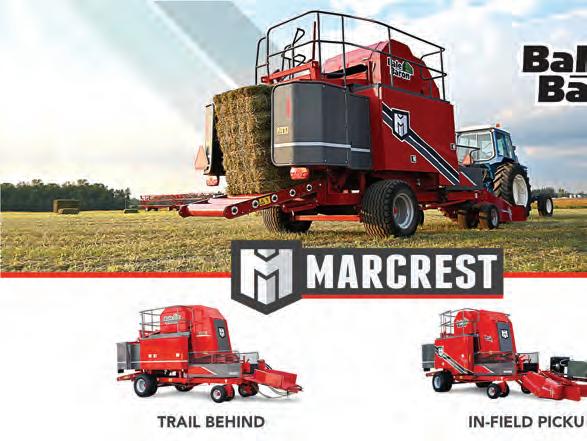









BUYERS MART August/September 2022 | hayandforage.com | 33 Full line of applicators. Exceptional customer service. Organic certified. Custom Operators Wanted N4852 County Road C ~ Ellsworth WI 54011 Office: 715 273 3739 Cell: 612 812 7939 www.multisile.com deatonnutrition@dishup.us Crop Specific Inoculant Haylage & Small Grains Haylage & Small Grains Haylage Grains Dry Hay Dry Hay Hay-up to 26% moisture up to 26% moisture up to 26% moisture Corn Silage Corn Silage Hi Hi Hi-Moisture Corn Moisture Corn Corn 4th Edition Feeding Guide by Mike Hutjens hoards.com/bookstore GOPHER GENERAL “Best gopher control I’ve ever seen. Our cost per acre has gone down after the first season of use. Just added a second machine to cover all our ground.” M.B. Walla Walla, WA Field-proven gopher control since 2010! Patented system blows slow-release fumigant tablets in the artificial tunnel, undetected, allowing time for gophers to find the tunnel and succumb to the fumigant. Cover 20 acres/hour with a fumigant cost of $10/acre! EFFECTIVE for days and in all SLOW-Release Fumigant CALL 306-745-2412 E-MAIL gophergeneral@gmail.com WATCH OUR VIDEO gophergeneral.com Machines operating in CO, ID, KS, MN, MT, ND, NE, NM, NV, OK, OR, SD, TX, UT, WA, and CANADA. SLOW-RELEASE FUMIGANT remains effective for days! STAY IN THE TRACTOR while Gopher General does the work for you! NO PLUGGING! WORKS IN ALL CONDITIONS Protects against rocks/obstacles; dry, muddy or hard ground conditions! LEARN MORE at our website! AprMay_GopherGen_NEW.indd 1 3/4/22 11:22 AM





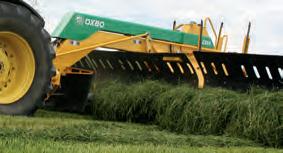
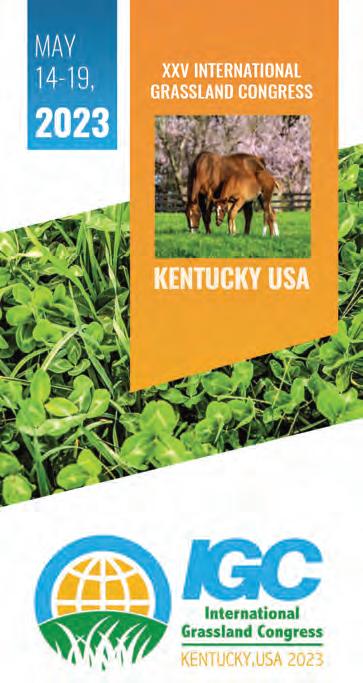


BUYERS MART 34 | Hay & Forage Grower | August/September 2022 ENTRIES MUST BE RECEIVED BY: SEPTEMBER 1, 2022 https://bit.ly/SE-hay-contest 2022 Sunbelt Ag Expo October 18–20, Moultrie, GA 7 individual categories awarded for top quality hay and baleage samples! Five Merger Models Ranging from 12 to 40-feet No matter the size of your operation, there is an Oxbo designed to fit your needs. WE LEAD. OTHERS FOLLOW. OXBO.COM 800.628.6196 See Your Local Dealer TODAY! Untitled-7 1 internationalgrasslands.org www.tubeline.ca 1.888.856.6613 @TubelineMFG


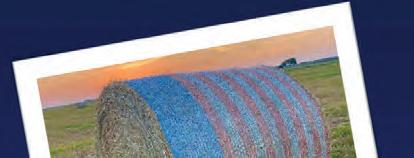

















August/September 2022 | hayandforage.com | 35 559-779-5961 sealprosilage.com Easy to buy, easy to use, US family-owned Contract your covering? Ask for Sealpro® by name ® BY CONNOR AGRISCIENCE SILA GE BA RR I ER FI LMS More. Better. Safer.™ with the FASTEST GROWING SILAGE BARRIER BRAND! Gallop into harvest season! 559-779-5961 (800) 552-3295 2022 World Alfalfa Congress Profitable Alfalfa Production Sustains the Environment November 14–17, 2022, San Diego, CA www.worldalfalfacongress.ucdavis.edu
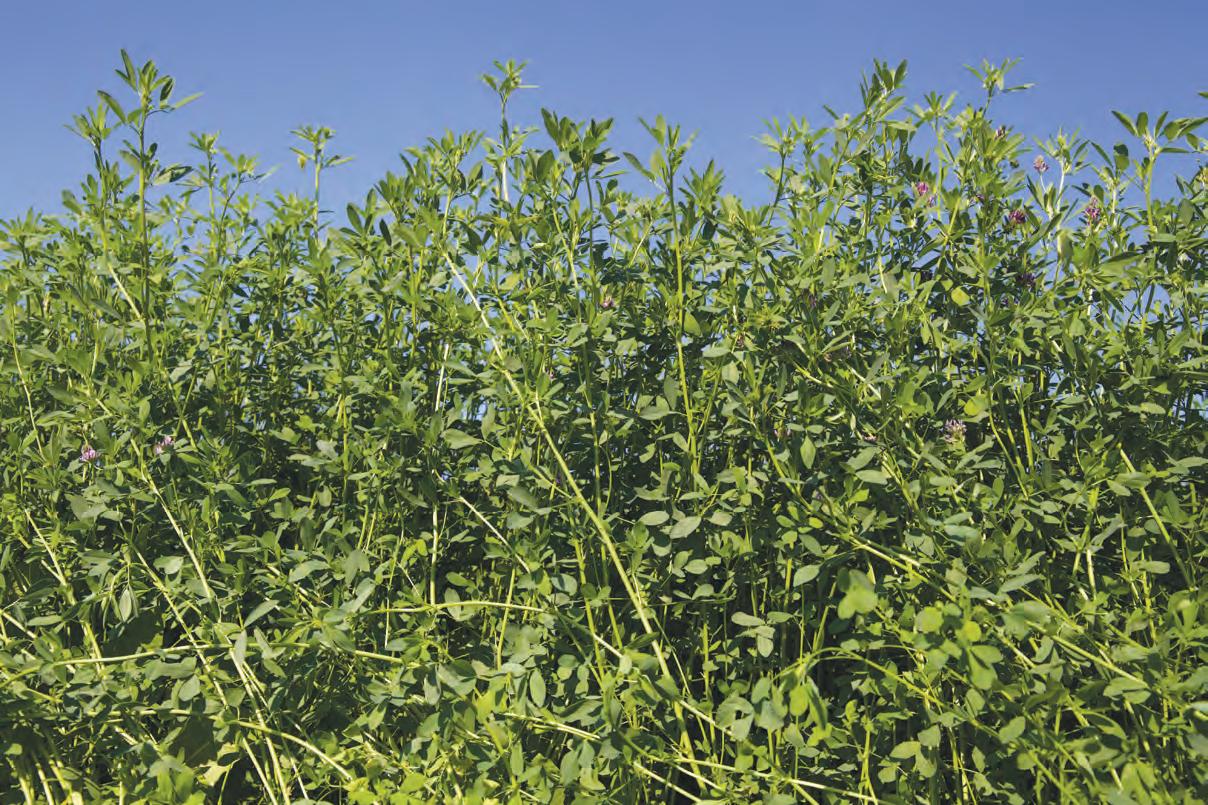


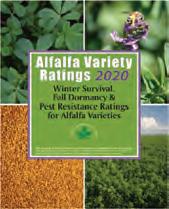





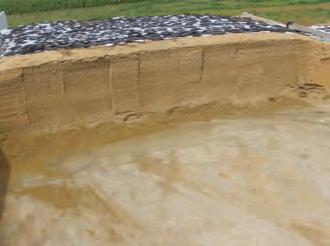



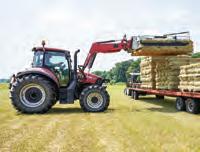

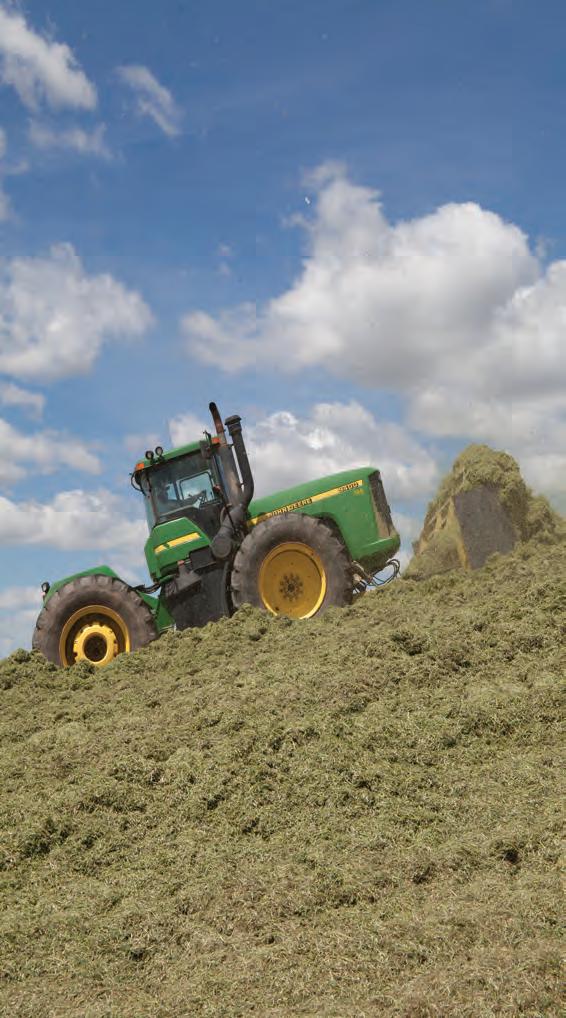


BUYERS MART 36 | Hay & Forage Grower | August/September 2022 NAFA Alfalfa Variety Ratings 2023 COMING SOON in the November issue of ONE PRODUCT, MANY USES, SAME GREAT RESULTS. S ILO- K I NG S ILO- K I NG Forage & Grain Treatment LEARN MORE PRODUCTS TO SIMPLIFY YOUR WORKLOAD Tie Bales Move Bales nordenmfg.com • 877-296-5851 Find a dealer • Get more information • Watch videos • Simplify your workload Formerly Kuhns Mfg, visit our website to read the story. CLASSIFIED ADVERTISING $2.50 per word per issue.10 word minimum. 920-563-5551 ext. 125 FARM EQUIPMENT BALEWAGONS: New Holland self-propelled & pull-type models/ parts/tires/manuals. Can finance/ deliver. 208-880-2889, www. balewagon.com JAWIBA/15 4 Safe practices 4 Educational Resources silagesafety.org SEND EVERYONE HOME SAFE SAFETY FOUNDATION

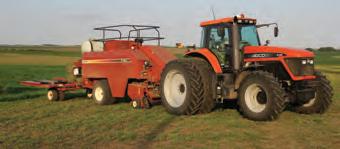


































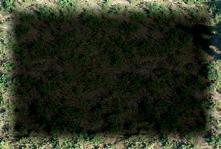






August/September 2022 | hayandforage.com | 37 BUYERS MART World’s Finest Hay Products Alfalfa Seed Plastic & Sisal Twine Net Wrap Hay Preservatives Silage Film Hay Tarps Conditioning Rollers Hay Fluffers Fair Manufacturing Hay Rakes 866-999-1006 www.thefinetwineco.com 1062 Junction Rd, Alton, IA 51003 FineTwine_March_HFG.indd 1 2/4/22 2:14 PM Baler-Wrapper Combination VARIO-Master & LT-Master • Variable Bale Sizes (24" - 54" diameter) • Maximum Bale Density • Many different Materials: Hemp ∙ Corn Silage ∙ CCM ∙ Alfalfa ∙ Sugar Beet Pulp ∙ Grass Silage TMR (Total Mixed Ration) ∙ Whole Crop Silage ∙ And much more VARIO-Master // Silage Baling E cient. Economical. Easy. • Improve forage quality • Maximize milk & meat yield • Reduce feed loss • Easily transport & sell bales www.goeweil.com Philip Kieser sales@goeweil.com | (309) 750-5639 INTERESTED? Contact us NOW • Easy to use all hydraulic operation • In-cab speed adjust • 31 ft. raking width • 7 bar system Introducing . . . 6707 Bar Rake The difference Better quality hay under varying conditions Proudly made in the USA
Farm Progress Show
August 30 to September 1, Boone, Iowa
Details: farmprogressshow.com
Husker Harvest Days
September 13 to 15, Grand Island, Neb. Details: huskerharvestdays.com
National Hay Association Convention
September 21 to 24, Perrysburg, Ohio Details: nationalhay.org
Kentucky Fall Grazing School
September 13 and 14, Versailles, Ky. Details: forages.ca.uky.edu/Events
World Dairy Expo
World Forage Analysis Superbowl
October 2 to 7, Madison, Wis. Hay crop entries due Aug. 25 Details: bit.ly/HFG-WFAS
Sunbelt Ag Expo
Southeastern Hay Contest
October 18 to 20, Moultrie, Ga. Hay contest entries due September 1 Details: bit.ly/HFG-SHC
Kentucky Grazing Conference
October 26 and 27 Leitchfield and Winchester, Ky. Details: forages.ca.uky.edu/Events
Heart of America Grazing Conference and MFGC Annual Forage Conference
November 2 and 3, Springfield, Mo. Details: www.missourifgc.org
World Alfalfa Congress
November 14 to 17, San Diego, Calif. Details: worldalfalfacongress.ucdavis. edu
American Forage & Grassland Council Annual Conference
January 8 to 11, Winston-Salem, NC Details: afgc.org
International Grassland Congress
May 14 to 19, Covington, Ky. Details: internationalgrasslands.org
Hay prices a mixed bag
Harvested hay acre projections by USDA were increased in their June Acreage report. Total harvested hay acres are now forecasted at 51.5 million, which is 1.5% higher than 2021. This is the first news we’ve had in some time that would have any tempering impact on hay prices.
That said, hay prices below reflect two different stories. In drought areas, prices are still on the increase. Steady to lower prices are seen in other areas. The prices below are primarily from USDA hay market reports as of the beginning of mid-July. Prices are FOB barn/stack unless otherwise noted. •
For weekly updated hay prices, go to “USDA Hay Prices” at hayandforage.com
Supreme-quality alfalfa Price $/ton Nebraska (Platte Valley)-lrb 160-180 California (central SJV) 475 (d)Nebraska (western) 225 California (intermountain) 350 Oklahoma (northwest)-lrb 230 (d) California (San Luis Valley) 450-460(d)Oregon (Klamath)-ssb 295 Colorado (northeast) 275 (d)Pennsylvania (southeast) 145-200 Colorado (southwest) 345 South Dakota 200-225 Idaho (south central) 340 South Dakota (Corsica)-lrb 170-200 Iowa (Rock Valley) 225-250Texas (west) 260-280(d) Kansas (northeast) 300Wisconsin (Lancaster)-lrb 180 Kansas (south central) 220-240Wyoming (western) 200-250 Kansas (southwest) 255 Fair-quality hay Price $/ton Missouri 225-275Colorado (San Luis Valley) 180 Nebraska (western) 245-250Idaho (south central) 285 (d) New Mexico (central) 355 Kansas (southeast) 160-180 Oklahoma (central) 275 (d)Kansas (south central)-lrb 145-175 Oklahoma (northwest)-lrb 250 (d)Minnesota (Pipestone)-lrb 155 Oregon (Lake County) 380Missouri-lrb 100-125 Texas (Panhandle) 310-385(d)Montana 220 Texas (west)-ssb 366-433New Mexico (north central) 125 (d) Washington 365Pennsylvania (southeast)-ssb 175
Premium-quality alfalfa Price $/ton South Dakota (Corsica)-lrb 165 California (San Luis Valley) 450(d)Washington 340 California (southeast) 365-370Wisconsin (Lancaster)-lrb 70 Colorado (northeast) 225-235 Wyoming (western) 160 Idaho (central) 315-317 Bermudagrass hay Price $/ton Idaho (western) 300Alabama-Premium lrb 150-200 Iowa (Rock Valley)-lrb 198-215Alabama-Good lrb 130 Kansas (north central) 250 California (southeast)-Prem/Sup ssb 345 Kansas (northwest) 250 California (southeast)-Good ssb 285 Minnesota (Pipestone)-lrb 240 Oklahoma (northwest)-Premium lrb 200 (d) Missouri 175-225Texas (central)-Good/Prem lrb 208-240 Montana 260 Texas (southern)-Good/Prem ssb 260-330 Nebraska (central) 250 Bromegrass hay Price $/ton Oregon (Crook-Wasco)-ssb 390 Kansas (northeast)-Good 140 (d) Oregon (Lake County) 400(o)Kansas (southeast)-Premium 185 Pennsylvania (southeast) 300 Orchardgrass hay Price $/ton South Dakota 250 Montana-Premium ssb 350 Texas (Panhandle) 280-305(d)Oregon (Crook-Wasco)-Premium ssb 425 Washington 370 Pennsylvania (southeast)-Good 190-230 Wyoming (eastern) 250 Pennsylvania (southeast)-Fair lrb 75 Wyoming (western)-ssb 270-300Wyoming (western)-Premium ssb 300 Good-quality alfalfa Price $/tonTimothy hay Price $/ton California (intermountain) 370 Idaho (south central)-Good/Premium 355 California (southeast) 340 Montana-Premium ssb 300 Colorado (northeast) 210 Oregon (Lake County)-Premium ssb 420 Colorado (southeast) 250 Pennsylvania (southeast)-Premium 190-235 Idaho (central) 285-300Pennsylvania (southeast)-Good lrb 120 Iowa (Rock Valley)-lrb 165 Washington-Premium 400 Kansas (northeast) 200 (d) Wheat Straw Price $/ton Kansas (southeast)-lrb 190 (d)Iowa (Rock Valley) 153 Minnesota (Pipestone)-lrb 190-195Kansas 60-100 Missouri-lrb 120-180Nebraska (central) 75 (d) Montana 250 Pennsylvania (southeast) 115-155 Nebraska (central)-lrb 175 (d)South Dakota-lrb 100-120
Abbreviations: d=delivered, lrb=large round bales, ssb=small square bales, o=organic
HAY MARKET UPDATE
FORAGE IQ 38 | Hay & Forage Grower | August/September 2022

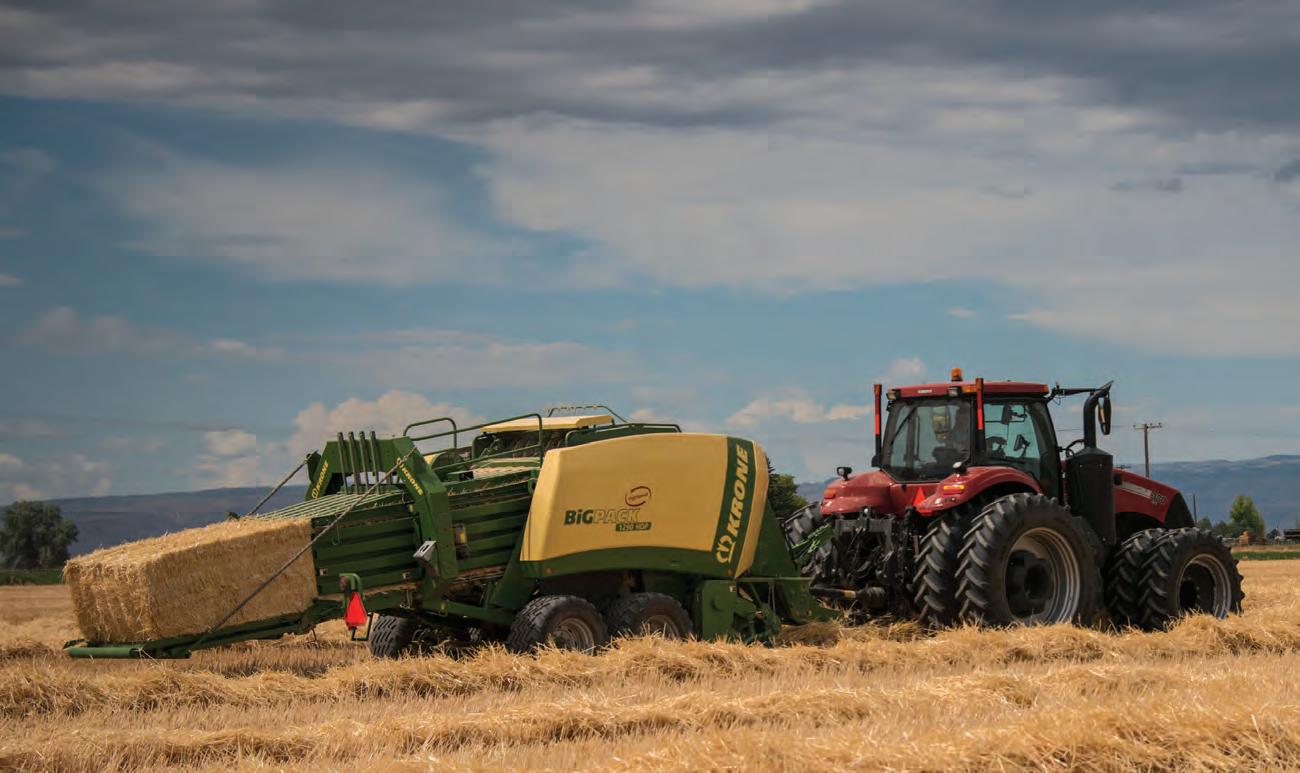






































































































CAPTURE THE BENEFITS OF BALING STRAW WITH THE KRONE 1290 HDP BiG PACK LARGE SQUARE BALERS Jeremy Vorwaller EMERY CREEK FARMS | RUPERT, IDAHO “ ” By switching to KRONE (balers), we were able to go from 25-ton truckloads of straw to 40-tons loads. PUT MORE STRAW IN EVERY BALE... To see more, visit offers.krone-northamerica.com Bi G PACK IN ACTION! WATCH THE
When it’s time to mow, you want to get it done without the frustration of complicated equipment. That’s why Massey Ferguson® DM Series disc mowers deliver straightforward and dependable options to help you cut your crop faster, whether you’re just cutting enough to keep your animals fed or you’re a professional contractor.
Learn more at www.masseyferguson.us , or visit your Massey Ferguson dealer today to get mowing.

 ©2022 AGCO Corporation. Massey Ferguson is a worldwide brand of AGCO Corporation. AGCO and Massey Ferguson are trademarks of AGCO. All rights reserved.
©2022 AGCO Corporation. Massey Ferguson is a worldwide brand of AGCO Corporation. AGCO and Massey Ferguson are trademarks of AGCO. All rights reserved.
SIMPLIFIED.
MOWING.








Platteville: 1625 US-151 BUS Platteville, WI 53818 Phone: (608) 407-3017 Appleton WI 54913 Phone: (920) 759-9060 SERVICE OF THE PRODUCER Deutz-Fahr | High Quality Tractors for all Operators’ Needs Powershift or TTV transmission LH reverser From 80-340 hp Top-of-the-line options - 3+ SCV’s, case drain, power beyond and more 540 & 1000 rpm PTO Optional front 3pt hitch and PTO



Corn Silage: From Seed to Feed Every ration needs a strong foundation. This 80-page, perfect bound manual explains best practices and references for each stage of corn silage management. Five expert authors detail guidelines for: • Production • Harvest • Storage • Feeding An ideal book for dairy producers, farm consultants, and dairy or agronomy students! Hoard’s Dairyman Books P.O. Box 801 • Fort Atkinson, WI 53538 920-563-5551 • hdbooks@hoards.com Order Today! $24.95 plus S&H Available at: www.hoards.com/silage or call 920-563-5551. NEW RELEASE!








































 ADAM VERNER
ADAM VERNER
















 by Hugh Aljoe and Steven Smith
by Hugh Aljoe and Steven Smith

 by Jennifer MacAdam and Mylen Bohle
by Jennifer MacAdam and Mylen Bohle












































































































































































































 ©2022 AGCO Corporation. Massey Ferguson is a worldwide brand of AGCO Corporation. AGCO and Massey Ferguson are trademarks of AGCO. All rights reserved.
©2022 AGCO Corporation. Massey Ferguson is a worldwide brand of AGCO Corporation. AGCO and Massey Ferguson are trademarks of AGCO. All rights reserved.










